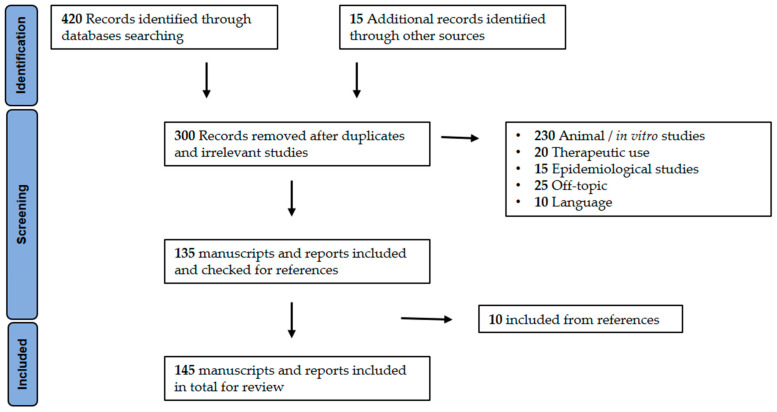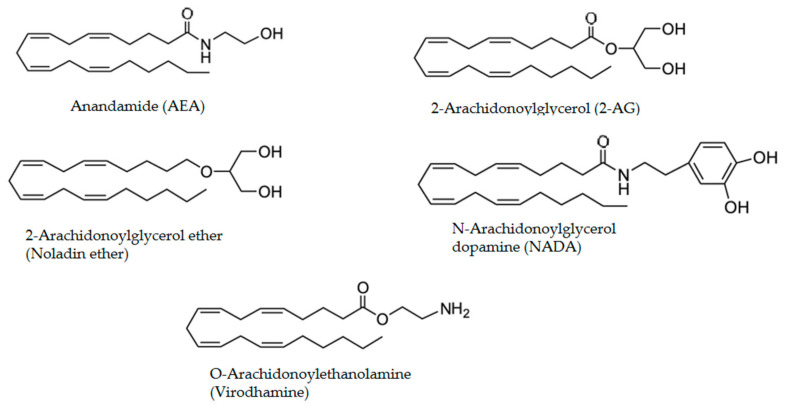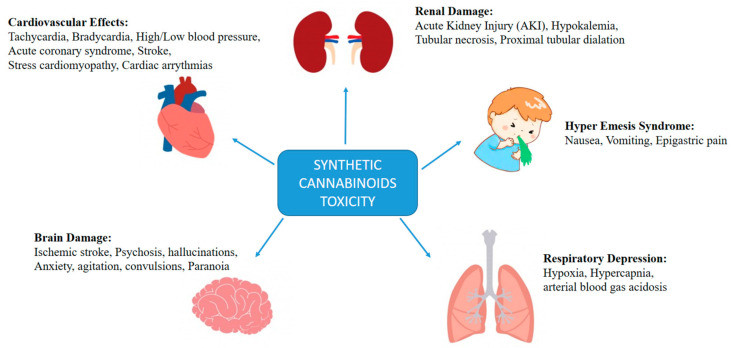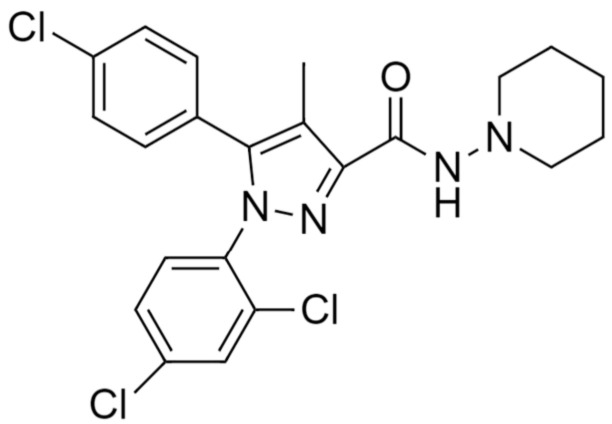Abstract
Synthetic Cannabinoids (CBs) are a novel class of psychoactive substances that have rapidly evolved around the world with the addition of diverse structural modifications to existing molecules which produce new structural analogues that can be associated with serious adverse health effects. Synthetic CBs represent the largest class of drugs detected by the European Monitoring Centre for Drugs and Drug Addiction (EMCDDA) with a total of 207 substances identified from 2008 to October 2020, and 9 compounds being reported for the first time. Synthetic CBs are sprayed on natural harmless herbs with an aim to mimic the euphoric effect of Cannabis. They are sold under different brand names including Black mamba, spice, K2, Bombay Blue, etc. As these synthetic CBs act as full agonists at the CB receptors, they are much more potent than natural Cannabis and have been increasingly associated with acute to chronic intoxications and death. Due to their potential toxicity and abuse, the US government has listed some synthetic CBs under schedule 1 classification. The present review aims to provide a focused overview of the literature concerning the development of synthetic CBs, their abuse, and potential toxicological effects including renal toxicity, respiratory depression, hyperemesis syndrome, cardiovascular effects, and a range of effects on brain function.
Keywords: synthetic cannabinoids, phytocannabinoids, Cannabis sativa, schedule 1 drugs, spice, K2, electronic cigarettes, herbal incense, bath salts, cloud 9, Mojo, John William Huffman (JWH), Hebrew University (HU), MDMB-4en-PINACA, 4F-MDMB-BICA
1. Introduction
The medicinal properties of the Cannabis sativa plant were included for the first time in the textbook of pharmacology Materia Medica by the Greek and Roman physicians in the first century AD. However, a more accurate description of the physiological effects of this plant was given by the ancient Indian and Chinese writers [1]. Cannabis sativa was originally cultivated in central Asia but subsequently spread to most areas of the world. It grows naturally but, due to its pleasurable psychological effects, is frequently cultivated indoors under artificial light [1]. Delta-9-tetrahydrocannabinol (THC) is its most recognised phytocannabinoid and major psychoactive compound [2]. Cannabidiol (CBD) and Cannabinol (CBN) are the other main ingredients and 85 other CBs with different pharmacological effects have been identified and isolated from Cannabis sativa [3,4,5].
Following the discovery of the structure and stereochemistry of THC, synthetic CBs were synthesized in the early 1960s to study the pharmacology of CB receptors and to investigate their therapeutic effects [6]. In Europe and the USA, synthetic CBs started to appear in the 2000s and 2008, respectively [7]. In July 2012, synthetic CBs have been classified as Schedule I based on their chemical structures by the Drug Enforcement Administration, which passed the Drug Abuse Prevention Act to decrease the sales and usage of the synthetic CBs [8]. To circumvent this restriction, new synthetic CB compounds were developed, some of which had an inadvertent range of adverse and potentially lethal effects [9]. In the last 20 years, the USA has experimented with legalised access to Cannabis and Cannabis-derived products for medical and recreational purposes, which has increased their availability in the market and led to increased heavy usage in the adult population [10]. The expanded legal access of Cannabis-derived products like chocolate squares, gummy bears, and candies are attracting younger age profile and has increased the incidence of adverse reactions in children [11]. Therefore, synthetic CBs spread easily due to their easy access and intelligent marketing, but they often display variable potency and unpredictable effects. Moreover, their consumption is often undetectable with available standard drug screening tests [12]. Synthetic CBs are manufactured in unregulated laboratories, purchased by local distributors who sell them to the customers by diluting in a solvent [13]. Some synthetic CBs are more toxic than THC with numerous adverse effects, including hypertension, tachycardia, hallucination, emesis, agitation, and seizures [14,15]. Cannabis is the world’s most abused drug, and its illicit usage is growing in schools. In the USA, nearly 2.6 million new users under 19 years of age are exposed to Cannabis annually [16]. In 2016, the United Nations Office on Drugs and Crime (UNODC) estimated that around 28 million adults (aged 15 to 64) have used Cannabis [17].
The World Health Organization (WHO) reported that Cannabis use has deleterious effects on the cardiovascular system and progressively it has been registered an increase of THC content in the Cannabis from 2–3% to 20% [18]. Since 1998, Cannabis has been legalised in 29 states of the USA for medical purposes. In 2017, as per estimations of the Cannabis Industry Annual Report, there is a legal market of US$7.97 billion, which is projected to increase by $24 billion by 2025 [19]. There are growing numbers of psychoactive synthetic CBs, which are 10 to 200 times more potent than THC. They are sprayed on harmless herbs, and they are distributed with different market names including Black mamba, K2, spice, Bombay Blue, and fake weed [20]. This explosive increase in the availability of CB variants is, unfortunately, increasing the incidence of deaths and fatalities [21].
In the context of the increasing popularity of synthetic CBs around the world, there is a rise in toxicity cases due to the usage of recreational Cannabis and its synthetic analogues. The main aim of this review is to discuss the adverse effects of synthetic CBs including kidney injury, hyperemesis syndrome, cardiovascular effects, respiratory depression, and brain damage.
2. Methodology
A literature search was conducted on multidisciplinary research databases such as PubMed, Scopus, and Web of Science and international agencies or institutional websites including the WHO, UNODC, Centers for Disease Control (CDC), U.S. Department of Justice, US FDA, US Drug Enforcement Administration (DEA), US National Institute of Health (NIH), EMCDDA, and European Medicines Agency (EMA) to identify the most relevant literature. The search terms used alone or in combination were: “synthetic cannabinoids”, “Cannabis sativa”, “Schedule 1 drugs”, “phytocannabinoids”, “spice”, “K2” “cannabinoids”, “electronic cigarettes”, “adverse effects”, “cloud 9”, “Bath salts”, “mojo”, “John William Huffman (JWH)”, “Hebrew University (HU)”, “EMCDDA”, “MDMB-4en-PINACA”, “4F-MDMB-BICA”, “toxic effects” and “herbal incense”. Only the articles written in English were selected. All the articles were reviewed independently by the authors to determine their relevance in the framework of the current study. Details of the literature search are listed in Figure 1.
Figure 1.
Flow diagram of study identification, screening, and selection.
3. Endogenous Cannabinoids and Receptors
N-arachidonoyl-ethanolamine (AEA) and 2-arachidonoyl glycerol (2-AG) are the two most studied endocannabinoids (eCBs), although other eCBs also exist, including 2-arachidonyl glycerol ether (Noladin ether), O-arachidonoyl ethanolamine (virodhamine), N-arachidonoyl glycine, and N-arachidonoyl dopamine (NADA) [22,23,24,25] (Figure 2).
Figure 2.
Chemical structures of the endocannabinoids.
AEA and 2-AG are lipophilic molecules and are synthesized de novo by cleavage of their membrane lipid precursors N-arachidonoyl-phosphatidylethanolamine (N-ArPE) and sn-1-acyl-2-arachidonoylglycerols (DAGs) respectively [26]. The enzymes N-acyl-phosphatidylethanolamine-selective phospholipase D (NAPE-PLD) and diacylglycerol lipase (DAGL) biosynthesise AEA and 2-AG, respectively; the enzymes fatty acid amide hydrolase (FAAH) and the monoacylglycerol lipases (MAGL) are involved in the degradation of AEA and 2-AG, respectively [27]. These enzymes, together with CB receptors and eCBs, are key components in the eCB system. AEA, named anadamide after the Sanskrit word ananda or “bliss”, was discovered in 1992 and functions as a partial agonist at CB type 1 (CB1) receptors but is inactive at CB type 2 (CB2) receptors [22]. AEA also interacts with other targets including the GPCR112, GPCR55, transient receptor potential vanilloid-1 (TRPV1) channels, alpha7-nicotinic acetylcholine receptors, T-type Ca2+ channels, Na2+ channels and voltage-gated K+ channels [28,29].
2-AG was identified in 1995 and acts as a full agonist at both CB1 and CB2 receptors [26,27]. The CB1 receptor was discovered on the basis of its responsiveness to THC and was first cloned in 1990 [22,30]. It is widely distributed in the body and the brain, CB1 is expressed at higher densities in basal ganglia, hippocampus, cortex, and cerebellum [31] the motor function, cognition, memory, and analgesia [32]. Significant levels of CB1 receptors are expressed in peripheral tissues including the adrenal gland, heart, lungs, prostate, bone marrow, thymus, tonsils, ovary, and testes [33]. The CB2 receptors were isolated in differentiated myeloid cells and cloned in 1993 [34]. CB2 receptor shares 44% amino acid homology with CB1 [35], is mainly expressed in macrophages, spleen, tonsils, thymus, leukocytes, lungs, and testes, and its stimulation is attributable to the anti-inflammatory and immunomodulatory actions of CB [36]. Both CB receptors are members of the G protein-coupled receptor (GPCR) family and are coupled to pertussis toxin (PTX)-sensitive Gi/o protein, suppress adenylyl cyclase (AC) and the formation of cyclic adenosine monophosphate levels (cAMP) upon receptor activation. CB1 receptor was found in both glutaminergic and GABAergic terminals and its activation at presynaptic levels can suppress the excitatory and inhibitory neurotransmission, respectively [37,38,39,40]. Synthetic CB receptor agonist is linked to the mitogen-activated protein kinase (MAPK) pathway, which results in phosphorylation of nuclear transcription factors influencing cellular transcription, translation, motility, shape, proliferation, and differentiation. Prolonged phosphorylation of CB1 receptors may lead to desensitisation and internalization that could impact respiratory depression indirectly [41,42].
Like the CB1, the CB2 receptors inhibit the activity of AC through their Gi/Goα subunits. Through their Gβγ subunits, CB2 receptors are also known to be coupled to the protein kinase C (PKC) leading to the activation of the MAPK and extracellular signal-regulated kinase (ERK) phosphorylation [43]. Therefore, CB2 receptors through the MAPK-ERK pathway can modulate a complex and highly conserved signal transduction pathway, which regulates several cellular processes in mature and developing tissues [43]. Moreover, CB2 receptor activation induces intracellular Ca2+ release from the endoplasmic reticulum, as well as an increase in mitochondrial Ca2+, via the phospholipase C (PLC) activation and inositol 1,4,5-triphosphate (IP3) production [44].
4. Cannabis sativa
Cannabis sativa, an important plant containing more than 600 pharmacologically active constituents, has been used medicinally for several hundred years and has a range of other applications due to its cellulose and woody properties. Cannabis is rich in phytocannabinoids, which are C21 or C22 groups of terpenophenolic compounds predominantly rich in THC, Δ9-Tetrahydrocannabivarin (THCV), CBD, CBN, cannabigerol (CBG), cannabichromene (CBC), and Cannabidivarin (CBV) [45]. The chemical structures of these above-written compounds and their properties are included in Table 1. Herbal preparations of cannabis for medical use are commercially available in the form of vaporizers, buccal sprays, oral capsules, decoctions, and oils [46].
Table 1.
List of phytocannabinoids with their structures, Ki, and key findings.
| Name | Structure | Ki/µM | Key Findings |
|---|---|---|---|
| Δ9-trans-Tetrahydrocannabinol |
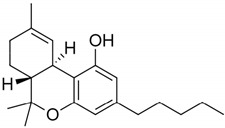
|
CB1—0.005 a 0.008 b 0.013 c CB2—0.003 a 0.0017 b 0.0068 c [45] |
THC inhibits Alzheimer’s disease (AD) pathology (by competitively inhibiting acetylcholinesterase enzyme and beta-amyloid (Aβ) peptide aggregation) [49] As analgesic for neuropathic pain [50,51] Bronchodialator effect on asthma patients [52] Effective to treat intractable cholestatic pruritus [53] Potent against methicillin-resistant Staphylococcus aureus (MRSA) strains (MIC- 2 µg/mL) * [54] Inhibit the proliferation of a hyper-proliferating human keratinocyte cell line in the treatment of psoriasis [55] |
| Δ9-Tetrahydrocannabivarin |
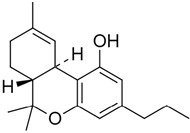
|
CB1—0.075 d 0.0047 e CB2—0.225 a 0.145 a [45] |
Exerts antiepileptiform and anticonvulsant properties in adult rats [56] Ameliorates insulin sensitivity and can be used to treat obesity-associated glucose intolerance [57] Δ8-Tetrahydrocannabivarin has potent anti-nicotine effects [58] Potent against MRSA strains (MIC—4 µg/mL) * [54] As a potential therapeutic benefit for the management of obesity and diabetes [59] |
| Cannabinol |
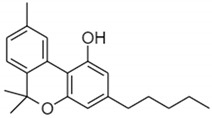
|
CB1—0.069 f 0.012 g CB2—0.016 g 0.07 f [45] |
Potent against MRSA strains (MIC—2 µg/mL) * [54] Inhibit the proliferation of a hyper-proliferating human keratinocyte cell line in the treatment of psoriasis [55] |
| Cannabidiol |
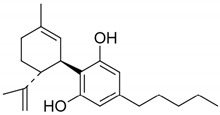
|
CB1—4.3 e 1.45 g CB2—2.86 f 0.37 g [45] |
Potent against MRSA strains (MIC—2 µg/mL) * [54] Inhibit the proliferation of a hyper-proliferating human keratinocyte cell line in the treatment of psoriasis [55] Potent inhibitor of transporter ABCC1 or MRP1 that helps in accumulation of anticancer drugs in cells [60] Protect against Aβ neurotoxicity in AD [61] Inhibits tau hyperphosphorylation in AD [62] Anti-arthritic by targeting synovial fibroblasts [63,64] Fluorinated derivatives of cannabidiol shows therapeutic activity as anxiolytic, antidepressant, antipsychotic, and anticompulsive [65] Prevents post-ischemic injury via HMGB1-inhibiting mechanism [66] |
| Cannabidivarin |
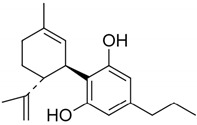
|
CB1—14.7 g CB2—0.57 g [45] |
Ameliorates autism-like behaviours, restores endocannabinoid signaling and neuroinflammation [67] Anti-convulsant [68] Potent against MRSA strains (MIC—8 µg/mL) * [54] |
| Cannabigerol |

|
CB1—0.896 g CB2—0.153 g [45] |
Anti-oxidant properties in macrophages [69] Can be used to treat inflammatory bowel disease [70] Potent anti-inflammatory agent in a model of multiple sclerosis (MS) [71] Cannabigerol derivative VCE-003.2 protects against mutant huntingtin-induced neurodegeneration [72] Cannabigerol derivative VCE-003 can be used in the treatment of human immune diseases [73] Potent against MRSA strains (MIC—2 µg/mL) * [54] Plays a neuroprotective role in the treatment of Huntington’s disease (HD) [74] |
| Cannabichromene |

|
CB1—0.71 g CB2—0.256 g [45] |
Potent against MRSA strains (MIC—8 µg/mL) * [54] Inhibit the proliferation of a hyper-proliferating human keratinocyte cell line in the treatment of psoriasis [55] Anti-inflammatory properties [75] |
MIC-Minimum Inhibitory Concentration; * Antibacterial Activity against MRSA USA300; Ki-inhibitory constant. a Assay—[3H]CP55-940 binding assay; Cell type-CHO cell membrane/Human. b Assay—[3H]CP55-940 binding assay; Cell type-CHO cell membrane/Mouse. c Assay—[3H]CP55-940 binding assay; Cell type-CHO cell membrane/Rat. d Assay—[3H]CP55-940 binding assay; Cell type-Whole-brain membranes/Mouse. e Assay—[3H]CP55-940 binding assay; Cell type-Cortical brain membranes/Rat. f Assay—[3H]CP55-940 binding assay; Cell type-CHO cell/Human. g Assay—[3H]CP55-940 binding assay; Cell type-Sf9 cells/Human.
THC is the major cannabinoid in Cannabis sativa and is most significant due to its pharmacological and toxicological properties. This plant is also rich in phenolic compounds such as flavonoids belonging to flavone and flavanol subclasses [47]. Cannabis contains about 120 phytocannabinoids and until recently eleven chemical classes of phytocannabinoids have been identified. Among them, THC class is the largest portion comprising 17.3% of the total phytocannabinoid content [48]. Phytocannabinoids can be classified into tricyclic (THC, THCV, and CBN), bicyclic (CBD, CBC, and CBV), and others (CBG).
5. Therapeutic Effects of Phytocannabinoids and Synthetic Cannabinoids
Despite the addictive potential of marijuana, Cannabis sativa has a very long history of medicinal usage. THC was isolated from hashish in 1964 by Raphel Mechoulam at Hebrew University, which led to the discovery of CB receptors. The functions of eCB, and the use of CB1 and CB2 receptors as targets for medical and other recreational purposes [76]. Synthetic CB agonists are increasingly used for the treatment of human pathological conditions and several CB antagonists are under clinical evaluation. Marijuana contains THC at different concentrations in the range of 40 to 80% and appears like honey or butter (brown or gold colour) and is usually consumed orally in the form of food or drink products, smoking by use of oil or water pipes. E-cigarettes/vaporizers are often preferred due to their smokelessness, odourless, and ability to hide from consuming marijuana concentrate [77]. Besides, the marijuana plant contains 60 cannabinoid-like structures out of its total 600 chemicals [78].
In both the brain and periphery, the eCB system modulates many physiological processes, which have some beneficial therapeutic effects in the treatment of pain, inflammation, epilepsy, cancer, eating disorders, and spasticity. CBs are effective in treating postoperative pain, cancer, and spinal cord injury [79]. Dronabinol, which is an appetite-increasing drug used in HIV patients, is a commercially available form of THC [80].
Some evidence also showed that in animal models, Cannabis smoke alleviated the tremors and spasticity associated with MS [81], and some clinical studies have shown that CBs could be used in combination therapy for treating cancer [82]. CBs exert inhibitory effects on glutamate, reactive oxygen species (ROS), and tumour necrosis factor indicating that they play a crucial role as neuroprotective agents [83,84,85,86]. Moreover, CBs may offer a potential treatment for Parkinson’s disease (PD) as they inhibit the excitatory effects of glutamate [87,88,89,90].
It has been demonstrated that CBs exert anti-cancer properties in a range of cancers [91]. CBs were preclinically determined to be potential antineoplastic agents against pancreatic cancers [92], breast cancers [93], gastric cancers [94], prostate cancers [95], leukaemia [96], skin carcinomas [97], cervical cancers [98], colon cancers [99], non-small cell lung cancers [100], hepatocarcinomas [101], bladder carcinomas [102] and multiple myeloma [103]. CBs, as anticancer treatments, can induce apoptosis [104], autophagy [105], and antiproliferative effects [106].
THC with its synthetic analogues nabilone (Cesamet®; Valeant Pharmaceuticals, Irvine, CA, USA) and dronabinol (Marinol®; Solvay Pharmaceuticals, Marietta, GA, USA) have been used to suppress nausea and vomiting associated with chemotherapy [107]. In this context, THC is thought to exert its pharmacological effects by decreasing 5-HT3 receptor activity [108]. In animal models, THC has demonstrated considerable neuroprotective effects and is capable of ameliorating the symptoms of neurodegenerative diseases, including PD, AD, HD, MS, and Amyotrophic Lateral Sclerosis (ALS) [108,109,110,111,112,113,114]. It has also been demonstrated that THC and cyclooxygenase-2 (COX-2) inhibitors can reduce Aβ plaques in degenerated neurons of AD animal model [115]. Following THC treatment, some mouse models of MS showed improved spasticity and tremors [116]. In clinical trials of MS patients, THC exerted both decreased urinary incontinence and antispasticity effects [117]. Although THC has its therapeutical effects, it also has psychoactive properties; alternately, CBD is less toxic than THC to humans and has been recognised as a nonpsychoactive compound [115].
The psychoactive properties of THC suggest that it may have considerable potential in the treatment of a range of psychological/psychiatric conditions; CBD exerts a wide range of positive therapeutic effects in psychosis, anxiety, and depression-like behaviours by neuroprotection and inhibiting neuroinflammatory responses. CBD can also act independent of cannabinoid receptors by modulating antioxidant mechanisms in PD animal models and attenuates dystonia [88,89,90]. In MS, CBD treatment can exert a neuroprotective role by diminishing inflammation through adenosine A2 receptors [115]. CBD reduces neuroinflammation and axonal damage of oligodendrocyte progenitor cells (OPC), which increases differentiation into new myelinating oligodendrocytes. Synthetic CBs protect the OPCs by controlling the stress response of the endoplasmic reticulum which modulates inflammatory stimuli [118]. Sativex®, an oromucosal spray (GW Pharmaceuticals, Cambridge, UK), showed positive results in clinical trials for MS and it is marketed in 16 countries outside of the USA. It has antispasmodic and analgesic properties containing a 1:1 ratio of plant extracted THC and CBD [119]. In 2007, a meta-analysis study conducted in MS treatment using Sativex®, CBD, and Marinol® showed that Sativex® has the highest efficacy in reducing the neuropathic pain with dizziness as the adverse effect [120]. USFDA approved synthetic drugs such as Marinol® (synthetic THC), is used to treat anorexia associated with weight loss in patients with AIDS (Acquired Immunodeficiency Syndrome), Cesamet® (nabilone), and Syndros® (synthetic THC) used for the treatment of nausea and vomiting due to chemotherapy [121].
6. Synthetic Cannabinoids as Drugs of Abuse
Cannabis has been used as a drug for centuries but in the nineteenth century, CBN was isolated, and its structure was partially described in 1932 [122]. In 1964, Raphael Mechoulam characterised the structure of THC, which lead to the development of THC analogues with small modifications in their structure which produce new moieties with similar activity, resulting in the production of synthetic CBs as potential drugs of abuse [123]. Since 2004 synthetic CBs have been sold in European countries such as Germany, Austria, Switzerland over the internet, which enabled very easy access to synthetic CBs without any age restriction [124].
Synthetic CBs are a novel range of psychoactive substances, which have similar effects like THC, and their potency depends on their structure and volume of consumption. It is believed that synthetic CBs are 800 times more potent than Cannabis [125]. The most commonly used name for synthetic CBs is spice, which is marketed as a relaxing herbal blend hiding its true composition. It is sold in black markets at a higher price than marijuana and gained its popularity due to its legality and negative drug test results. In mid-2008, spice’s popularity reached peak levels in Germany, leading to an epidemic of accidents and mental disorders in spice users [126]. Spice is known as K2 in the USA [127], which rapidly became a drug of abuse and as a consequence got banned in 2010 [128].
Initial attempts failed to explain the narcotic effects of spice products because the manufacturers claimed that it has a herbal composition. However, it was gradually understood that the herbal ingredients do not induce significant psychoactive effects [129]. Suspicion arose that spice products had been mixed with synthetic CBs, but there was insufficient analytical data to reach this conclusion. These blends contain the JWH series of drugs developed by John W. Huffman while working at Clemson University and the HU series of drugs developed at HU [130]. In 2008, the German pharmaceutical company THC Pharm has isolated a synthetic CB JWH-018 from 3 spice varieties of the synthetic CBs [13], and two other research teams at Freiburg University (Germany) [124]. The National Scientific Institute of Health (Japan) [131] identified the presence of C8 homolog of synthetic CBs including JWH-018, CP 47497 which were subsequently made illegal by the German regulatory bodies and other European countries [129]. To stay ahead of the enforcement measures, illegal drug teams synthesized new kinds of synthetic CBs which were similar to the prohibited and banned chemical structures including JWH-073, which is a butyl homolog of JWH-018. New synthetic CBs are structurally related to the prohibited molecules with slight changes. To overcome this issue, the Russian Government released Resolutions of No.882 and No.1178 defining the term “drug derivative”. Nevertheless, the drug traffickers then synthesized new molecules with a range of innovative structural modifications [132].
In contemporary society, large-scale synthetic CBs were manufactured illegally for recreational purposes due to their high potency and undetectability by conventional drug screening tests. Alterations and substitutions of the chemical moieties in THC produced more than 700 synthetic CBs and some of them have active metabolites [133]. JWH-018 is a synthetic CB, which is a full agonist to CB1 and CB2 receptors and can cause hallucinations, vertigo, paresthesias, shaking, shivering, hypertension, dry mouth, vomiting, mydriasis, hypokalemia, extrasystoles, tachycardia and conjunctival hyperemia [134]. Recent data shows that K2, the synthetic CB, can cause ischemic stroke [135] and further data is needed to understand the toxic effects of synthetic THC on brain mitochondria [136]. Liquid chromatography-tandem mass spectroscopy (LC-MS) helps in analysing the synthetic CBs in serum samples derived from people suspected to use spice. The spice varies in its chemical constituents as per the supplier and it can include toxic chemicals like oleamide, linoleic acid, palmitic acid, palmitoylethanolamide, eugenol, thymol, acetyl vanillin, benzyl benzoate, α-tocopherol, vitamin E, and β2-adrenergic agonist [137]. JWH-018 and CP 47497 were the first CBs to be identified in spice using Gas chromatography-mass spectrometry (GC-MS) chromatography [138]. It has been demonstrated in mice that co-administration of JWH-018 and JWH-073 can produce addictive, synergistic, and antagonistic interactions [139].
Synthetic CBs were sold as a legal replacement for Cannabis and attracted a lot of attention for having the same powerful intoxicating effects. Moreover, there was also an increase in availability of e-liquid products containing a mixture of cannabinoids in a solvent that is vaped using an electronic cigarette. Smuggling of cannabinoids into prison in some countries is facilitated by impregnating paper (such as letters, greeting cards, photographs, children’s drawings) with cannabinoids and then vaped using electronic cigarettes, this can pose a high risk of poisoning due to high degrees of cannabinoid variability in different parts of the paper [140]. Many adverse health issues have been reported in USA, Russia, Canada, and Europe due to the misspelling or adulteration of the product. For instance, synthetic CBs in Europe are sold as ecstasy, while in the USA and Canada, opioids like heroine are adulterated with synthetic CBs [141].
As previously mentioned, the limited availability of selective and sensitive rapid analytical methods for screening the synthetic CBs is representing a challenge in elucidating the heterogenous structures. Colorimetric and immunochemical assays were found to be inappropriate for rapid and specific detection due to frequent cross-reactivity and can take more time for the production of antibodies. While chromatographic assays proved to be more suitable due to high flexibility, sensitivity, and selectivity even at low doses. The hyphenated techniques like GC-MS and/or LC-MS are the best promising tools but are expensive [142].
In New Zealand and Australia, a potent cannabinoid known as Kronic came into the market after spice and Dream in 2011, and unfortunately caused the death of a huge number of young people [143]. New synthetic CBs, such as JWH-250, JWH-398 [129,144], AM-694 [145], RCS-4 [146], AM2233 [147] are constantly emerging in the market with new chemical moieties to prevent their identification and regulation as illicit substances [132]. Due to their potential toxicity and abuse, the USA government has listed some synthetic CBs under schedule 1, which contain drugs, substances, or chemicals defined by the federal government with no currently accepted medical use and high potential of abuse. Some schedule 1 synthetic cannabimimetic agents are listed in Table 2 with their structures and other relative information [148].
Table 2.
List of schedule 1 synthetic cannabinoids with their structures and adverse effects.
| Name | Structure | Receptors | Adverse Effects |
|---|---|---|---|
| CP47,497 (5-(1,1-dimethylheptyl)-2-[(1R,3S)-3-hydroxycyclohexyl]-phenol) |
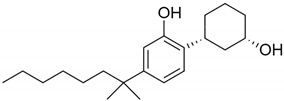
|
CB1 and CB2 agonist [149] | Increased heart rate, high/low blood pressure, coughing, and, vomiting [150] |
| JWH-018 (1-pentyl-3-(1-naphthoyl)indole) |
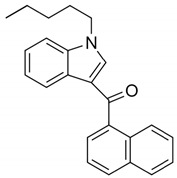
|
CB1 and CB2 agonist [149] | Psychosis [151], hallucinations, vertigo, paresthesias, shaking, shivering, hypertension, dry mouth, vomiting, mydriasis, hypokalemia, extrasystoles, tachycardia, conjunctival hyperemia [134], and ischemic stroke [135] |
| JWH-073 (1-butyl-3-(1-naphthoyl)indole) |
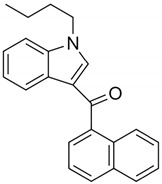
|
CB1 and CB2 agonist [149,152] | Altered mood and perception, red or bloodshot eyes, nausea, vomiting, listlessness, fever, sweating, and dryness of the mouth [150] |
| JWH-019 (1-hexyl-3-(1-naphthoyl)indole) |
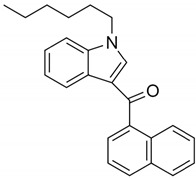
|
CB1 and CB2 agonist [152] | Confused speech, unstable appearance [150] |
| JWH-250 (1-pentyl-3-(2-methoxyphenylacetyl)indole) |
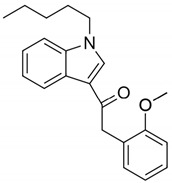
|
CB1 and CB2 agonist [149] | Dilated unresponsive pupils and bloodshot eyes [153] |
| JWH-081 (1-pentyl-3-[1-(4-methoxynaphthoyl)]indole) |
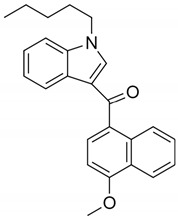
|
CB1 and CB2 agonist [152] | Slurred speech [153] |
| JWH-122 (1-pentyl-3-(4-methyl-1-naphthoyl)indole) |
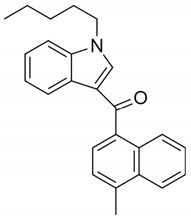
|
Agonist at CB1 and CB2 [154] | Hallucinations, disorientation, sedation, anxiety, agitation, tachycardia, hypertension, dyspnea, nausea, vomiting, hyperglycemia, and hypokalemia [155] |
| AM2201 (1-(5-fluoropentyl)-3-(1-naphthoyl)indole) |
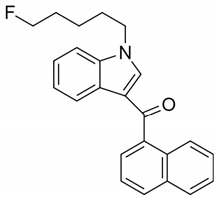
|
Agonist at CB1 and CB2 [156] | Convulsions [157], Excitatory behavior, xerostomia, chest pain, severe dyspnea, tachycardia (150 beats/min), and mild hypertension [158] |
| AM694 (1-(5-fluoropentyl)-3-(2-iodobenzoyl)indole) |
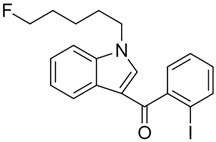
|
Agonist at CB1 [159] | Agitation, hallucination, anxiety, and paranoia [159] |
| JWH-203 (1-pentyl-3-(2-chlorophenylacetyl)indole) |

|
Agonist at CB1 and CB2 [156] | Head twitching, slurred speech, hallucination, dilated unresponsive pupils and bloodshot eyes [153] |
According to the recent report released in December 2020 by EMCDDA, 207 emergent synthetic CBs were monitored in the drug market since 2008 which include nine compounds reported for the first time up until the end of October 2020. Besides, from 2011 to 2015, 27 compounds appeared on average every year in Europe but, from 2016 this number dropped to around 10 [160]. Seizures related to synthetic CBs reported by the European Union (EU) Early Warning System were 19,705 in 2019 representing 46% of the total seizures during the year and in which, synthetic CBs were mainly detected in herbal plant material (5977 cases-138 kgs) in the form of powder (728 cases-84 kgs). However, in recent years, a sharp decrease has been observed in seizing the powder quantity and herbal materials containing synthetic CBs in the EU. But two synthetic CBs MDMB-4en-PINACA [161] and 4F-MDMB-BICA (or 4F-MDMB-BUTICA) [162] were observed during 2020, increasing the potential threat to public health in EU and their details are reported in Table 3.
Table 3.
Two synthetic CBs MDMB-4en-PINACA and 4F-MDMB-BICA concerning EU. Reprinted from ref [160].
| MDMB-4en-PINACA | 4F-MDMB-BICA | |
|---|---|---|
| Structure |
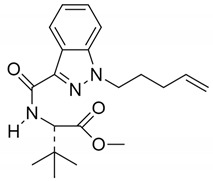
|
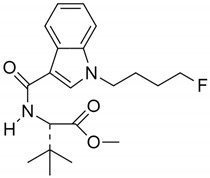
|
| Molecular Formula | C20H27N3O3 | C20H27FN2O3 |
| Form | Yellow powder | White powder [163] |
| Availability | Since 2017 | Since 2020 |
| Cases reported | 768 seizures as of October 2020. 11 acute non-fatal poisonings in the United Kingdom (UK) 4 confirmed deaths were reported in total by Sweden and UK |
108 seizures as of October 2020 21 deaths reported by Hungary between May and August 2020 |
The aim of developing the synthetic CBs was for research purposes but the published scientific literature on the synthesis of synthetic CBs has been misused by criminally inclined chemists to produce huge amounts of synthetic CB products for illicit commercial use [164] and was sold under the brand names Spice, K2, Black Mamba, Scooby snax [165], herbal incense, Cloud 9, and Mojo [6].
Synthetic CB intoxication leads to different physiological and psychological effects including psychosis [166], respiratory depression [42], renal toxicity [167], hyperemesis syndrome [168], cardiovascular effects [169], gastrointestinal problems [170], seizures [171], and acute cerebral ischemia [171]. Therefore, synthetic CB usage is associated with toxic effects on the body and multiple organ failure. Figure 3 describes the adverse effects of synthetic CBs, which are further discussed in this review.
Figure 3.
Toxicity of synthetic cannabinoids and their adverse effects.
7. Toxicological Effects of Synthetic Cannabinoids
7.1. Renal Injury
Kidneys are the vital organs in maintaining the fluid homeostasis of the body, regulating and filtering the minerals from the blood, producing hormones, that are important in producing the red blood cells (RBC), promoting bone health, and regulating blood pressure. Kidney damage is associated with a higher rate of morbidity and mortality due to its involvement in significant functions of the body. Synthetic CBs, which are often used as recreational drugs, are emerging in the market due to their greater availability at cheaper prices with comparable psychoactive effects as Cannabis with adverse renal effects [172]. Renal biopsy studies revealed that people addicted to synthetic CBs are suffering from tubular necrosis and proximal tubular dilatation [167]. Long-term use of synthetic CBs damages the kidney with abnormal urinalysis and increased levels of creatinine levels in blood [157].
Evidence suggests that both CB1 and CB2 receptors are involved in the pathogenesis of acute kidney injury (AKI) in mice. CB1 expression has been found in different regions of the nephron in rodents, including afferent arterioles, efferent arterioles [173], glomerulus [174], thick ascending loop of Henle [175], tubular epithelial cells [176], and cultured mesangial cells [177]. CB1 receptors have been detected in proximal convoluted tubules, distal tubules, and intercalated cells of the collecting duct in human kidneys [178]. CB2 receptors are expressed in podocytes [179], proximal tubule cells [180], mesangial cells of human and rat renal cortex samples [181].
The eCB system in kidneys plays an important role through its increased CB1 receptor activity contributing to hemodynamic abnormalities and dysfunction. A series of studies in nephrotoxic models of cisplatin-induced renal injury demonstrated that there are detrimental effects due to CB1 activation and protective effects by CB2 activation. CB1 activation results in increased expression of oxidative/nitrosative stress marker, which activates pathways such as MAPK, P38, c-Jun N-terminal kinase pathways leading to apoptotic cell death and inflammation [182]. On the contrary, CB2 activation leads to reduced proapoptotic signalling, involved in anti-inflammatory effects by decreasing the release of cytokines [183].
Buser and colleagues reported two clinical cases regarding the effect of synthetic CBs on kidney function. In one of the cases, a 17-year-old patient smoked a synthetic CB called Clown Loyal and presented with symptoms of flank pain, emesis, and oliguria. Later, the patient was treated with furosemide for oliguria and intravenous methylprednisolone (500 mg for 3 days) for suspected acute interstitial nephritis, followed by oral prednisone (30 mg twice daily). Renal biopsy conducted on the third day exposed the real condition of the kidney that the patient is having an acute tubular injury with mild interstitial nephritis. In another case, 15-year-old reported to have discomfort and renal ultrasound revealed bilateral hyperechoic kidneys with poor corticomedullary differentiation [184]. Illicit use of synthetic CBs increased the number of illness cases. In addition, 16 cases were reported of AKI in six states of the USA in March 2012 [185], and four cases of oliguric AKI in 2013 [167]. Acute tubular necrosis seems to be the aetiology of AKI in patients [186].
7.2. Cannabinoid Hyperemesis Syndrome
Cannabinoid hyperemesis syndrome (CHS) is a condition with cyclic vomiting due to high doses of Cannabis. Cannabis has been used for many years, but CHS was first reported in 2004 [187]. The patients suffering from this condition had to undergo a lot of expensive medical tests for symptom management. The pathophysiology of CHS is less known, which hinders proper treatment of this condition [188]. CHS has been given less importance and underestimated but now, many cases have been identified in recent years showing the widespread use of Cannabis throughout the world. There are some sceptical and unclear circumstances under which Cannabis suppresses emesis in some people, and induces in others. This needs to be clarified. It is difficult to understand the exact pathophysiology of CHS, as some data suggest that it is due to dysregulation of the eCB receptors CB1 and CB2 in the brain and gastric system [189], while other data suggest that interaction of CBs with CB1 in gastrointestinal tract changes the gastric motility. Widespread use of synthetic CBs increases CHS cases day by day as they are potent against CB1 receptors [190].
A case report of a 37-year-old African American male who is suffering from intermittent symptoms like nausea, vomiting and epigastric pain for the last 14 years has a history of long-term use of Cannabis and to relieve the symptoms the patient applies heat to the abdomen [191]. It remains a puzzle how CBs induce hyperemesis despite its antiemetic property demonstrated in clinical and animal models, by stimulating CB1 receptors [192]. Hundreds of metabolites formed from the active components of Cannabis and the non-active components could trigger the cyclic hyperemesis following chronic abuse [193]. Abdominal heat application with hot showers helps in the redistribution of heat around the gastrointestinal tract and relieves the symptoms of CHS [194]. One case report suggests that chronic use of CBs may turn CHS into Cyclic Vomiting Syndrome (CVS) [191]. A study conducted by Simonetto and colleagues on 98 patients concluded that CHS symptoms occur in patients who use Cannabis frequently for many years and start to decline after the cessation of the Cannabis use [195].
Nausea and vomiting associated with cancer chemotherapy can be treated with THC (Dronabinol) and the synthetic cannabinoid nabilone which were approved for medical use in the USA. The difference between anti-emetic doses and adverse (psychic) effects of these drugs is too narrow, which limits its usage as anti-emetic in a clinical context. However, the introduction of 5-HT3 receptor antagonists as new anti-emetics emerged as a better option to replace cannabinoids [196].
7.3. Cardiovascular Effects
Smoking Cannabis causes an immediate increase in heart rate lasting more than an hour, and in half an hour there is an increase in serum norepinephrine levels [197]. Increased supine systolic blood pressure is noticed on acute exposure to Cannabis [198] that may induce atrial fibrillation [199]. Cannabis smokers have reduced levels of oxygen in their blood due to increased levels of carboxyhemoglobin [200]. Moreover, Cannabis is found to be a source of ROS, which increases cellular oxidative stress [201].
Cardiovascular cases increased from 1.1% in 2006 to 3.6% in 2010. The commonly reported cardiovascular cases of Cannabis users are acute coronary syndrome (ACS), stroke, stress cardiomyopathy, cardiac arrhythmias, and death [202]. Nearly a five-fold increase in the risk of acute myocardial infarction (AMI) after Cannabis exposure was described [203]. CBs can reduce myocardial contractility by acting on CB1 receptors [204] and many cases have been reported regarding the rhythm abnormalities in Cannabis users [205]. It has been reported that young users (14 years old age) were found to have atrial fibrillation after Cannabis smoke [206].
Acute myocardial infarction in marijuana smokers was increased, 4.8-fold higher during the first hour of exposure, and declined rapidly [203]. An investigation revealed that recreational marijuana usage by young adults (age 25–34 years) led to a 17% increased hospitalisation due to ischaemic stroke and 18% due to aneurysmal subarachnoid haemorrhage [207]. Other cases presented with acute myocardial infarction after smoking spice or k2 with chest pain in 16-year-old boys [169].
7.4. Respiratory Depression
Synthetic CBs act on peripheral receptors, such as chemoreceptors and baroreceptors, increasing the resistance on bronchial air passage. Activation of CB1 receptors could be a possible reason for respiratory depression by stimulating signalling pathways linked to G-protein coupled receptor, MAPK which leads to the suppression of excitatory and inhibitory neuronal activity [41].
The effect of synthetic CBs in respiration has not been studied extensively on humans and research on rats had shown that they affect the respiratory rate and can cause hypoxia, hypercapnia, and arterial blood gas acidosis [208]. Inhalation of synthetic CBs causes the release of harmful chemical gases which damage the bronchial epithelial lining and damages the protective surfactant layer in alveoli leading to changes in the gaseous exchange causing hypoxia and acute respiratory distress [209]. The chronic use of synthetic CBs leads to dependence syndrome, withdrawal symptoms, and psychiatric symptoms [145]. Severe respiratory depression, pneumothorax, and acute respiratory distress syndrome (ARDS) can be developed after synthetic CBs use. In a 25-year-old boy in Turkey, it was found that after consumption of synthetic CBs, the pulmonary parenchymal tissue was damaged, causing vasoconstriction and endothelial dysfunction [210].
Synthetic CBs can act as full agonists, partial agonists, and inverse agonists at CB1 and CB2 receptors, and have different levels of potency, efficacy, affinity, selectivity, and molecular activity [211]. Contrarily, natural THC shows only partial agonistic activity [212].
Marijuana smoke is comparatively more harmful than tobacco smoke to the lungs and induces bronchial hyperresponsiveness, pulmonary inflammation, emphysema, and tissue destruction independent of CB1 activation. A single marijuana cigarette per day is equivalent to one package of tobacco cigarettes in inducing the risk of malignancy tumours every year. Twice the concentrations of harmful chemicals including phenol, naphthalene benzanthracene, acetaldehyde, hydrogen cyanide, and ammonia are present in marijuana compared to tobacco smoke. These toxic irritants activate peptidergic sensory nerves which induces inflammation. In blood carboxyhemoglobin levels are five times higher in marijuana smokers compared to tobacco smokers [213]. A 29-year-old male patient who smoked bonzai, a synthetic CB derivative, for 2 years suffered from pulmonary embolism, a clinical condition that is associated with a higher rate of morbidity and mortality [214]. Similarly, another 32-year-old female patient also suffered pulmonary embolism due to the use of synthetic CBs [215].
7.5. Effects on Brain
In the brain, CB1 receptors are extensively distributed in regions like the hippocampus, basal ganglia, cortex, amygdala, and cerebellum. Cannabis induces dose-dependent toxicological changes in these brain regions [216]. There are changes in grey or white matter density in different regions of the brain including the frontal and parietal lobes [217] and degenerative changes in the hippocampus and amygdala are reported more often [218]. These findings suggest that Cannabis use leads to changes in the morphology and function of brain structures involved in learning and memory [219,220]. Battistella and colleagues showed that there was a decrease in grey matter volume in regions, including the temporal cortex, temporal pole, parahippocampal gyrus, left insula, and orbitofrontal cortex in regular Cannabis users as compared with occasional users [221]. The same results have been found in animal studies, which further corroborate that Cannabis exposure results in volume reduction of CB1 rich regions [216].
Functional magnetic resonance imaging (FMRI) studies also demonstrate that there are alterations in core regions of the brain including the ventromedial prefrontal cortex (vmPFC), insula, and orbitofrontal cortices, which are linked to motivation and decision making [222]. However, in addition to changes in the polar region of the brain, changes have also been noted in the medial temporal cortex. The hypothesis of the reduction in grey matter volume suggests that it is due to abnormal pruning of the synaptic connections [223], which damages the brain maturation process. The exogenous CBs interfere with the normal functioning process of the eCBs and alter the pruning activity of the synapses in brain regions including the cerebellum [224] and prefrontal cortex [37,38,40,85,225].
In a 50-year-old male, fluid attenuation inversion recovery (FLAIR) imaging studies have shown that synthetic CB usage led to abnormally intense signals in the hippocampus, basal ganglia, bifrontal cortex, cerebral peduncles, posteroinferior cerebellar hemispheres, and cerebellar vermis [226]. Other designer drugs like “Bath salts”, which have similar effects to cocaine, induce acute intraparenchymal and subarachnoid haemorrhage as well as ischemic infarction [227]. Bath salt intoxication in a 36-year-old man led to delayed encephalopathy, dysautonomia, fulminant hepatic failure, and renal failure from severe rhabdomyolysis [228], and in a 14-year-old girl, this was accompanied by hyponatremia [229].
Synthetic drugs that selectively act as antagonists of CB1 or CB2 receptors [230], and rimonabant (SR141716A), a selective CB1 receptor blocker [231], has been used widely in CNS (Figure 4). In mice, it has been observed that direct microinjection of synthetic CB CP55940 into the cerebellum did not impair motor coordination [232]. Administration of THC, synthetic CBs, and anandamide in animals caused deficits in short-term memory in a spatial learning task [37,220,233].
Figure 4.
Rimonabant (SR141716A)-Chemical structure of CB1 selective antagonist drug.
To evaluate the effect of synthetic THC, research was performed on isolated rat brain mitochondria, and it induced negative effects on mitochondrial respiratory chain complexes I, II, III and increased the leakage of free radicals on exposure to THC. Moreover, mitochondria also participate in the overproduction of ROS in the presence of THC. Thus, the brain is vulnerable to oxidative stress and mitochondrial dysfunction, which increases neuronal damage and leads to the chance of stroke [140]. In other research, it has been reported that HU210, a synthetic analogue of THC, induces a spatial deficit in the Morris water maze test in learning reference memory [234].
8. Conclusions
Phytocannabinoids from the herb Cannabis sativa have been used for thousands of years for both medicinal and recreational purposes. Characterisation of the endocannabinoid system in the past two decades has developed an enhanced understanding concerning the roles of CB1 and CB2 receptors, which made it possible to use plant-derived cannabinoids in therapeutic implications. USFDA approved synthetic drugs such as Cesamet® used in severe nausea and vomiting, Marinol® and Syndros® used in AIDS-related anorexia, and antiemetic. Sativex®, an oromucosal spray used for the treatment of MS is marketed in 16 countries outside of the USA.
Elucidating the structure of THC in 1964 led to the development of THC analogues with similar activity and increased the production of synthetic CBs. Though the aim of developing the synthetic CBs was for research purposes, it was misused by clandestine chemists for criminal activities and currently, they are manufactured illegally on a large scale for illegal commercial use. Synthetic CBs have evolved and become popular rapidly in the world of recreational drugs of abuse due to their psychoactive properties. In recent times, many SCs have been banned and placed under the schedule 1 category in the USA because of their potentially harmful effects. However, new synthetic CBs with modifications in their chemical structure are available in the market with increased potential toxicity that threatens public health. Adverse effects associated with synthetic CBs include seizures, cardiovascular effects, kidney injury, respiratory depression, hyperemesis syndrome, gastrointestinal problems, cerebral ischemia, and multiple organ failure leading to death. Therefore, there is an urgent need to stop the spread and usage of these synthetic CBs in various forms and to further understand the toxic effects of synthetic CBs to develop treatments for intoxication.
Acknowledgments
Published with a contribution from the Department of Medical and Surgical Sciences, University of Foggia and from 5 × 1000 IRPEF funds in favour of the University of Foggia, in memory of Gianluca Montel.
Author Contributions
V.N.B., M.A.: Conceptualized, conceived, collected the information for the review, and provided significant contribution in writing the original manuscript, drawing all the figures and tables. R.V., G.S. and T.C.: Drafted the paper and supervised the work. All authors have read and agreed to the published version of the manuscript.
Funding
This research received no external funding.
Institutional Review Board Statement
Not applicable.
Informed Consent Statement
Not applicable.
Data Availability Statement
Data is sharing not applicable.
Conflicts of Interest
We declare that none of the authors have a conflict of interest.
Footnotes
Publisher’s Note: MDPI stays neutral with regard to jurisdictional claims in published maps and institutional affiliations.
References
- 1.Mechoulam R. Cannabinoids as Therapeutic Agents. Chapman and Hall/CRC; Boca Raton, FL, USA: 2019. The Pharmacohistory of Cannabis Sativa; pp. 1–20. [DOI] [Google Scholar]
- 2.Dos Santos R.G., Hallak J.E., Leite J.P., Zuardi A.W., Crippa J.A. Phytocannabinoids and epilepsy. J. Clin. Pharm. Ther. 2015;40:135–143. doi: 10.1111/jcpt.12235. [DOI] [PubMed] [Google Scholar]
- 3.Cassano T., Villani R., Pace L., Carbone A., Bukke V.N., Orkisz S., Avolio C., Serviddio G. From Cannabis sativa to Cannabidiol: Promising Therapeutic Candidate for the Treatment of Neurodegenerative Diseases. Front. Pharmacol. 2020;11:124. doi: 10.3389/fphar.2020.00124. [DOI] [PMC free article] [PubMed] [Google Scholar]
- 4.El-Alfy A.T., Ivey K., Robinson K., Ahmed S., Radwan M., Slade D., Khan I., ElSohly M., Ross S. Antidepressant-like effect of delta9-tetrahydrocannabinol and other cannabinoids isolated from Cannabis sativa L. Pharmacol. Biochem. Behav. 2010;95:434–442. doi: 10.1016/j.pbb.2010.03.004. [DOI] [PMC free article] [PubMed] [Google Scholar]
- 5.Pisanti S., Malfitano A.M., Ciaglia E., Lamberti A., Ranieri R., Cuomo G., Abate M., Faggiana G., Proto M.C., Fiore D., et al. Cannabidiol: State of the art and new challenges for therapeutic applications. Pharmacol. Ther. 2017;175:133–150. doi: 10.1016/j.pharmthera.2017.02.041. [DOI] [PubMed] [Google Scholar]
- 6.Mills B., Yepes A., Nugent K. Synthetic Cannabinoids. Am. J. Med Sci. 2015;350:59–62. doi: 10.1097/MAJ.0000000000000466. [DOI] [PubMed] [Google Scholar]
- 7.Wehrman J. Fake Marijuana Spurs More Than 3,000 Calls to US Poison Centers. [(accessed on 10 July 2021)];2011 Available online: https://www.drugcaucus.senate.gov/sites/default/files/AAPCC%20National%20Press%20Release%20K2%2C%20Spice%203-28-2011.pdf.
- 8.PUBLIC LAW 112–144—JULY 9. Title XI of the Food and Drug Administration Safety and Innovation Act. [(accessed on 21 June 2021)];2012 Available online: https://www.congress.gov/112/plaws/publ144/PLAW-112publ144.pdf.
- 9.Law R., Schier J., Martin C., Chang A., Wolkin A. Centers for Disease Control (CDC). Notes from the Field: Increase in Reported Adverse Health Effects Related to Synthetic Cannabinoid Use—United States, January–May 2015. MMWR. Morb. Mortal. Wkly. Rep. 2015;64:618–619. [PMC free article] [PubMed] [Google Scholar]
- 10.Williams A.R., Santaella-Tenorio J., Mauro C.M., Levin F.R., Martins S.S. Loose regulation of medical marijuana programs associated with higher rates of adult marijuana use but not cannabis use disorder. Addiction. 2017;112:1985–1991. doi: 10.1111/add.13904. [DOI] [PMC free article] [PubMed] [Google Scholar]
- 11.Lavi E., Rekhtman D., Berkun Y., Wexler I. Sudden onset unexplained encephalopathy in infants: Think of cannabis intoxication. Eur. J. Pediatrics. 2016;175:417–420. doi: 10.1007/s00431-015-2639-9. [DOI] [PubMed] [Google Scholar]
- 12.Lindigkeit R., Boehme A., Eiserloh I., Luebbecke M., Wiggermann M., Ernst L., Beuerle T. Spice: A never ending story? Forensic Sci. Int. 2009;191:58–63. doi: 10.1016/j.forsciint.2009.06.008. [DOI] [PubMed] [Google Scholar]
- 13.Griffiths P., Sedefov R., Gallegos A., Lopez D. How globalization and market innovation challenge how we think about and respond to drug use: “Spice” a case study. Addiction. 2010;105:951–953. doi: 10.1111/j.1360-0443.2009.02874.x. [DOI] [PubMed] [Google Scholar]
- 14.Harris C.R., Brown A. Synthetic cannabinoid intoxication: A case series and review. J. Emerg. Med. 2013;44:360–366. doi: 10.1016/j.jemermed.2012.07.061. [DOI] [PubMed] [Google Scholar]
- 15.Lapoint J., James L.P., Moran C.L., Nelson L.S., Hoffman R.S., Moran J.H. Severe toxicity following synthetic cannabinoid ingestion. Clin. Toxicol. 2011;49:760–764. doi: 10.3109/15563650.2011.609822. [DOI] [PMC free article] [PubMed] [Google Scholar]
- 16.Foley J.D. Adolescent use and misuse of marijuana. Adolesc. Med. Clin. 2006;17:319–334. doi: 10.1016/j.admecli.2006.03.008. [DOI] [PubMed] [Google Scholar]
- 17.United Nations Office on Drugs and Crime World Drug Report. United Nations Publication, Sales No. E.18.XI.9. 2018. [(accessed on 26 June 2021)]. Available online: https://reliefweb.int/sites/reliefweb.int/files/resources/WDR18_Booklet_1_EXSUM.pdf.
- 18.World Health Organization The Health and Social Effects of Nonmedical Cannabis Use. WHO Document Production Services. 2016. [(accessed on 21 July 2021)]. Available online: https://www.who.int/substance_abuse/publications/msbcannabis.pdf.
- 19.New Frontier Data The Cannabis Industry Annual Report: 2017 Legal Marijuana Outlook. 2017. [(accessed on 25 June 2021)]. Available online: https://newfrontierdata.com/wp-content/uploads/2015/11/CIAR_Webinar_FINAL.pdf.
- 20.United Nations Office on Drugs and Crime World Drug Report. United Nations publication, Sales No. E.15.XI.6. 2015. [(accessed on 19 June 2021)]. Available online: http://www2.juridicas.unam.mx/marihuana-caso-mexico/wp-content/uploads/2016/02/World_Drug_Report_2015-ONU.pdf.
- 21.Kasper A.M., Ridpath A.D., Arnold J.K., Chatham-Stephens K., Morrison M., Olayinka O., Parker C., Galli R., Cox R., Preacely N., et al. Severe Illness Associated with Reported Use of Synthetic Cannabinoids—Mississippi, April 2015. MMWR. Morb. Mortal. Wkly. Rep. 2015;64:1121–1122. doi: 10.15585/mmwr.mm6439a7. [DOI] [PubMed] [Google Scholar]
- 22.Devane W.A., Hanus L., Breuer A., Pertwee R.G., Stevenson L.A., Griffin G., Gibson D., Mandelbaum A., Etinger A., Mechoulam R. Isolation and structure of a brain constituent that binds to the cannabinoid receptor. Science. 1992;258:1946–1949. doi: 10.1126/science.1470919. [DOI] [PubMed] [Google Scholar]
- 23.Hanus L., Abu-Lafi S., Fride E., Breuer A., Vogel Z., Shalev D.E., Kustanovich I., Mechoulam R. 2-arachidonyl glyceryl ether, an endogenous agonist of the cannabinoid CB1 receptor. Proc. Natl. Acad. Sci. USA. 2001;98:3662–3665. doi: 10.1073/pnas.061029898. [DOI] [PMC free article] [PubMed] [Google Scholar]
- 24.Huang S.M., Bisogno T., Trevisani M., Al-Hayani A., De Petrocellis L., Fezza F., Tognetto M., Petros T.J., Krey J.F., Chu C.J., et al. An endogenous capsaicin-like substance with high potency at recombinant and native vanilloid VR1 receptors. Proc. Natl. Acad. Sci. USA. 2002;99:8400–8405. doi: 10.1073/pnas.122196999. [DOI] [PMC free article] [PubMed] [Google Scholar]
- 25.Porter A.C., Sauer J.M., Knierman M.D., Becker G.W., Berna M.J., Bao J., Nomikos G.G., Carter P., Bymaster F.P., Leese A.B., et al. Characterization of a novel endocannabinoid, virodhamine, with antagonist activity at the CB1 receptor. J. Pharmacol. Exp. Ther. 2002;301:1020–1024. doi: 10.1124/jpet.301.3.1020. [DOI] [PubMed] [Google Scholar]
- 26.Basavarajappa B.S. Critical enzymes involved in endocannabinoid metabolism. Protein Pept. Lett. 2007;14:237–246. doi: 10.2174/092986607780090829. [DOI] [PMC free article] [PubMed] [Google Scholar]
- 27.Long J.Z., Nomura D.K., Vann R.E., Walentiny D.M., Booker L., Jin X., Burston J.J., Sim-Selley L.J., Lichtman A.H., Wiley J.L., et al. Dual blockade of FAAH and MAGL identifies behavioral processes regulated by endocannabinoid crosstalk in vivo. Proc. Natl. Acad. Sci. USA. 2009;106:20270–20275. doi: 10.1073/pnas.0909411106. [DOI] [PMC free article] [PubMed] [Google Scholar]
- 28.Bukke V.N., Archana M., Villani R., Romano A.D., Wawrzyniak A., Balawender K., Orkisz S., Beggiato S., Serviddio G., Cassano T. The Dual Role of Glutamatergic Neurotransmission in Alzheimer’s Disease: From Pathophysiology to Pharmacotherapy. Int. J. Mol. Sci. 2020;21:7452. doi: 10.3390/ijms21207452. [DOI] [PMC free article] [PubMed] [Google Scholar]
- 29.Van der Stelt M., Di Marzo V. Anandamide as an intracellular messenger regulating ion channel activity. Prostaglandins Other Lipid Mediat. 2005;77:111–122. doi: 10.1016/j.prostaglandins.2004.09.007. [DOI] [PubMed] [Google Scholar]
- 30.Matsuda L.A., Lolait S.J., Brownstein M.J., Young A.C., Bonner T.I. Structure of a cannabinoid receptor and functional expression of the cloned cDNA. Nature. 1990;346:561–564. doi: 10.1038/346561a0. [DOI] [PubMed] [Google Scholar]
- 31.Glass M., Dragunow M., Faull R.L. Cannabinoid receptors in the human brain: A detailed anatomical and quantitative autoradiographic study in the fetal, neonatal and adult human brain. Neuroscience. 1997;77:299–318. doi: 10.1016/S0306-4522(96)00428-9. [DOI] [PubMed] [Google Scholar]
- 32.Szabo B., Schlicker E. Effects of cannabinoids on neurotransmission. Handb. Exp. Pharmacol. 2005:327–365. doi: 10.1007/3-540-26573-2_11. [DOI] [PubMed] [Google Scholar]
- 33.Galiegue S., Mary S., Marchand J., Dussossoy D., Carriere D., Carayon P., Bouaboula M., Shire D., Le Fur G., Casellas P. Expression of central and peripheral cannabinoid receptors in human immune tissues and leukocyte subpopulations. Eur. J. Biochem. 1995;232:54–61. doi: 10.1111/j.1432-1033.1995.tb20780.x. [DOI] [PubMed] [Google Scholar]
- 34.Munro S., Thomas K.L., Abu-Shaar M. Molecular characterization of a peripheral receptor for cannabinoids. Nature. 1993;365:61–65. doi: 10.1038/365061a0. [DOI] [PubMed] [Google Scholar]
- 35.Pertwee R.G., Howlett A.C., Abood M.E., Alexander S.P., Di Marzo V., Elphick M.R., Greasley P.J., Hansen H.S., Kunos G., Mackie K., et al. International Union of Basic and Clinical Pharmacology. LXXIX. Cannabinoid receptors and their ligands: Beyond CB(1) and CB(2) Pharmacol. Rev. 2010;62:588–631. doi: 10.1124/pr.110.003004. [DOI] [PMC free article] [PubMed] [Google Scholar]
- 36.Brown S.M., Wager-Miller J., Mackie K. Cloning and molecular characterization of the rat CB2 cannabinoid receptor. Biochim. Biophys. Acta. 2002;1576:255–264. doi: 10.1016/S0167-4781(02)00341-X. [DOI] [PubMed] [Google Scholar]
- 37.Antonelli T., Tomasini M.C., Tattoli M., Cassano T., Tanganelli S., Finetti S., Mazzoni E., Trabace L., Steardo L., Cuomo V., et al. Prenatal exposure to the CB1 receptor agonist WIN 55,212-2 causes learning disruption associated with impaired cortical NMDA receptor function and emotional reactivity changes in rat offspring. Cereb. Cortex. 2005;15:2013–2020. doi: 10.1093/cercor/bhi076. [DOI] [PubMed] [Google Scholar]
- 38.Castaldo P., Magi S., Cataldi M., Arcangeli S., Lariccia V., Nasti A.A., Ferraro L., Tomasini M.C., Antonelli T., Cassano T., et al. Altered regulation of glutamate release and decreased functional activity and expression of GLT1 and GLAST glutamate transporters in the hippocampus of adolescent rats perinatally exposed to Delta(9)-THC. Pharmacol. Res. 2010;61:334–341. doi: 10.1016/j.phrs.2009.11.008. [DOI] [PubMed] [Google Scholar]
- 39.Castaldo P., Magi S., Gaetani S., Cassano T., Ferraro L., Antonelli T., Amoroso S., Cuomo V. Prenatal exposure to the cannabinoid receptor agonist WIN 55,212-2 increases glutamate uptake through overexpression of GLT1 and EAAC1 glutamate transporter subtypes in rat frontal cerebral cortex. Neuropharmacology. 2007;53:369–378. doi: 10.1016/j.neuropharm.2007.05.019. [DOI] [PubMed] [Google Scholar]
- 40.Ferraro L., Tomasini M.C., Cassano T., Bebe B.W., Siniscalchi A., O’Connor W.T., Magee P., Tanganelli S., Cuomo V., Antonelli T. Cannabinoid receptor agonist WIN 55,212-2 inhibits rat cortical dialysate gamma-aminobutyric acid levels. J. Neurosci. Res. 2001;66:298–302. doi: 10.1002/jnr.1224. [DOI] [PubMed] [Google Scholar]
- 41.Alon M.H., Saint-Fleur M.O. Synthetic cannabinoid induced acute respiratory depression: Case series and literature review. Respir. Med. Case Rep. 2017;22:137–141. doi: 10.1016/j.rmcr.2017.07.011. [DOI] [PMC free article] [PubMed] [Google Scholar]
- 42.Jinwala F.N., Gupta M. Synthetic cannabis and respiratory depression. J. Child Adolesc. Psychopharmacol. 2012;22:459–462. doi: 10.1089/cap.2011.0122. [DOI] [PubMed] [Google Scholar]
- 43.Turcotte C., Blanchet M.R., Laviolette M., Flamand N. The CB2 receptor and its role as a regulator of inflammation. Cell. Mol. Life Sci. CMLS. 2016;73:4449–4470. doi: 10.1007/s00018-016-2300-4. [DOI] [PMC free article] [PubMed] [Google Scholar]
- 44.Zoratti C., Kipmen-Korgun D., Osibow K., Malli R., Graier W.F. Anandamide initiates Ca(2+) signaling via CB2 receptor linked to phospholipase C in calf pulmonary endothelial cells. Br. J. Pharmacol. 2003;140:1351–1362. doi: 10.1038/sj.bjp.0705529. [DOI] [PMC free article] [PubMed] [Google Scholar]
- 45.Turner S.E., Williams C.M., Iversen L., Whalley B.J. Molecular Pharmacology of Phytocannabinoids. Prog. Chem. Org. Nat. Prod. 2017;103:61–101. doi: 10.1007/978-3-319-45541-9_3. [DOI] [PubMed] [Google Scholar]
- 46.Brunetti P., Pichini S., Pacifici R., Busardo F.P., Del Rio A. Herbal Preparations of Medical Cannabis: A Vademecum for Prescribing Doctors. Medicina. 2020;56:237. doi: 10.3390/medicina56050237. [DOI] [PMC free article] [PubMed] [Google Scholar]
- 47.Flores-Sanchez I.J., Verpoorte R. Secondary metabolism in cannabis. Phytochem. Rev. 2008;7:615–639. doi: 10.1007/s11101-008-9094-4. [DOI] [Google Scholar]
- 48.Galal A.M., Slade D., Gul W., El-Alfy A.T., Ferreira D., Elsohly M.A. Naturally occurring and related synthetic cannabinoids and their potential therapeutic applications. Recent Pat. CNS Drug Discov. 2009;4:112–136. doi: 10.2174/157488909788453031. [DOI] [PubMed] [Google Scholar]
- 49.Eubanks L.M., Rogers C.J., Beuscher A.E.t., Koob G.F., Olson A.J., Dickerson T.J., Janda K.D. A molecular link between the active component of marijuana and Alzheimer’s disease pathology. Mol. Pharm. 2006;3:773–777. doi: 10.1021/mp060066m. [DOI] [PMC free article] [PubMed] [Google Scholar]
- 50.Atwal N., Casey S.L., Mitchell V.A., Vaughan C.W. THC and gabapentin interactions in a mouse neuropathic pain model. Neuropharmacology. 2019;144:115–121. doi: 10.1016/j.neuropharm.2018.10.006. [DOI] [PubMed] [Google Scholar]
- 51.Rahn E.J., Hohmann A.G. Cannabinoids as pharmacotherapies for neuropathic pain: From the bench to the bedside. Neurother. J. Am. Soc. Exp. Neurother. 2009;6:713–737. doi: 10.1016/j.nurt.2009.08.002. [DOI] [PMC free article] [PubMed] [Google Scholar]
- 52.Williams S.J., Hartley J.P., Graham J.D. Bronchodilator effect of delta1-tetrahydrocannabinol administered by aerosol of asthmatic patients. Thorax. 1976;31:720–723. doi: 10.1136/thx.31.6.720. [DOI] [PMC free article] [PubMed] [Google Scholar]
- 53.Neff G.W., O’Brien C.B., Reddy K.R., Bergasa N.V., Regev A., Molina E., Amaro R., Rodriguez M.J., Chase V., Jeffers L., et al. Preliminary observation with dronabinol in patients with intractable pruritus secondary to cholestatic liver disease. Am. J. Gastroenterol. 2002;97:2117–2119. doi: 10.1111/j.1572-0241.2002.05852.x. [DOI] [PubMed] [Google Scholar]
- 54.Klahn P. Cannabinoids-Promising Antimicrobial Drugs orIntoxicants with Benefits? Antibiotics. 2020;9:297. doi: 10.3390/antibiotics9060297. [DOI] [PMC free article] [PubMed] [Google Scholar]
- 55.Wilkinson J.D., Williamson E.M. Cannabinoids inhibit human keratinocyte proliferation through a non-CB1/CB2 mechanism and have a potential therapeutic value in the treatment of psoriasis. J. Dermatol. Sci. 2007;45:87–92. doi: 10.1016/j.jdermsci.2006.10.009. [DOI] [PubMed] [Google Scholar]
- 56.Hill A.J., Weston S.E., Jones N.A., Smith I., Bevan S.A., Williamson E.M., Stephens G.J., Williams C.M., Whalley B.J. Delta(9)-Tetrahydrocannabivarin suppresses in vitro epileptiform and in vivo seizure activity in adult rats. Epilepsia. 2010;51:1522–1532. doi: 10.1111/j.1528-1167.2010.02523.x. [DOI] [PubMed] [Google Scholar]
- 57.Wargent E.T., Kepczynska M., Zaibi M.S., Hislop D.C., Arch J.R.S., Stocker C.J. High fat-fed GPR55 null mice display impaired glucose tolerance without concomitant changes in energy balance or insulin sensitivity but are less responsive to the effects of the cannabinoids rimonabant or Delta(9)-tetrahydrocannabivarin on weight gain. PeerJ. 2020;8:e9811. doi: 10.7717/peerj.9811. [DOI] [PMC free article] [PubMed] [Google Scholar]
- 58.Xi Z.X., Muldoon P., Wang X.F., Bi G.H., Damaj M.I., Lichtman A.H., Pertwee R.G., Gardner E.L. Delta(8) -Tetrahydrocannabivarin has potent anti-nicotine effects in several rodent models of nicotine dependence. Br. J. Pharmacol. 2019;176:4773–4784. doi: 10.1111/bph.14844. [DOI] [PMC free article] [PubMed] [Google Scholar]
- 59.Abioye A., Ayodele O., Marinkovic A., Patidar R., Akinwekomi A., Sanyaolu A. Delta9-Tetrahydrocannabivarin (THCV): A commentary on potential therapeutic benefit for the management of obesity and diabetes. J. Cannabis Res. 2020;2:6. doi: 10.1186/s42238-020-0016-7. [DOI] [PMC free article] [PubMed] [Google Scholar]
- 60.Holland M.L., Allen J.D., Arnold J.C. Interaction of plant cannabinoids with the multidrug transporter ABCC1 (MRP1) Eur. J. Pharmacol. 2008;591:128–131. doi: 10.1016/j.ejphar.2008.06.079. [DOI] [PubMed] [Google Scholar]
- 61.Iuvone T., Esposito G., Esposito R., Santamaria R., Di Rosa M., Izzo A.A. Neuroprotective effect of cannabidiol, a non-psychoactive component from Cannabis sativa, on beta-amyloid-induced toxicity in PC12 cells. J. Neurochem. 2004;89:134–141. doi: 10.1111/j.1471-4159.2003.02327.x. [DOI] [PubMed] [Google Scholar]
- 62.Esposito G., De Filippis D., Carnuccio R., Izzo A.A., Iuvone T. The marijuana component cannabidiol inhibits beta-amyloid-induced tau protein hyperphosphorylation through Wnt/beta-catenin pathway rescue in PC12 cells. J. Mol. Med. 2006;84:253–258. doi: 10.1007/s00109-005-0025-1. [DOI] [PubMed] [Google Scholar]
- 63.Brunetti P., Lo Faro A.F., Pirani F., Berretta P., Pacifici R., Pichini S., Busardo F.P. Pharmacology and legal status of cannabidiol. Ann. Istituto Super. Sanita. 2020;56:285–291. doi: 10.4415/ANN_20_03_06. [DOI] [PubMed] [Google Scholar]
- 64.Lowin T., Tingting R., Zurmahr J., Classen T., Schneider M., Pongratz G. Cannabidiol (CBD): A killer for inflammatory rheumatoid arthritis synovial fibroblasts. Cell Death Dis. 2020;11:714. doi: 10.1038/s41419-020-02892-1. [DOI] [PMC free article] [PubMed] [Google Scholar]
- 65.Breuer A., Haj C.G., Fogaca M.V., Gomes F.V., Silva N.R., Pedrazzi J.F., Del Bel E.A., Hallak J.C., Crippa J.A., Zuardi A.W., et al. Fluorinated Cannabidiol Derivatives: Enhancement of Activity in Mice Models Predictive of Anxiolytic, Antidepressant and Antipsychotic Effects. PLoS ONE. 2016;11:e0158779. doi: 10.1371/journal.pone.0158779. [DOI] [PMC free article] [PubMed] [Google Scholar]
- 66.Hayakawa K., Mishima K., Irie K., Hazekawa M., Mishima S., Fujioka M., Orito K., Egashira N., Katsurabayashi S., Takasaki K., et al. Cannabidiol prevents a post-ischemic injury progressively induced by cerebral ischemia via a high-mobility group box1-inhibiting mechanism. Neuropharmacology. 2008;55:1280–1286. doi: 10.1016/j.neuropharm.2008.06.040. [DOI] [PubMed] [Google Scholar]
- 67.Zamberletti E., Gabaglio M., Piscitelli F., Brodie J.S., Woolley-Roberts M., Barbiero I., Tramarin M., Binelli G., Landsberger N., Kilstrup-Nielsen C., et al. Cannabidivarin completely rescues cognitive deficits and delays neurological and motor defects in male Mecp2 mutant mice. J. Psychopharmacol. 2019;33:894–907. doi: 10.1177/0269881119844184. [DOI] [PubMed] [Google Scholar]
- 68.Hill T.D., Cascio M.G., Romano B., Duncan M., Pertwee R.G., Williams C.M., Whalley B.J., Hill A.J. Cannabidivarin-rich cannabis extracts are anticonvulsant in mouse and rat via a CB1 receptor-independent mechanism. Br. J. Pharmacol. 2013;170:679–692. doi: 10.1111/bph.12321. [DOI] [PMC free article] [PubMed] [Google Scholar]
- 69.Giacoppo S., Gugliandolo A., Trubiani O., Pollastro F., Grassi G., Bramanti P., Mazzon E. Cannabinoid CB2 receptors are involved in the protection of RAW264.7 macrophages against the oxidative stress: An in vitro study. Eur. J. Histochem. EJH. 2017;61:2749. doi: 10.4081/ejh.2017.2749. [DOI] [PMC free article] [PubMed] [Google Scholar]
- 70.Borrelli F., Fasolino I., Romano B., Capasso R., Maiello F., Coppola D., Orlando P., Battista G., Pagano E., Di Marzo V., et al. Beneficial effect of the non-psychotropic plant cannabinoid cannabigerol on experimental inflammatory bowel disease. Biochem. Pharmacol. 2013;85:1306–1316. doi: 10.1016/j.bcp.2013.01.017. [DOI] [PubMed] [Google Scholar]
- 71.Granja A.G., Carrillo-Salinas F., Pagani A., Gomez-Canas M., Negri R., Navarrete C., Mecha M., Mestre L., Fiebich B.L., Cantarero I., et al. A cannabigerol quinone alleviates neuroinflammation in a chronic model of multiple sclerosis. J. Neuroimmune Pharmacol. Off. J. Soc. NeuroImmune Pharmacol. 2012;7:1002–1016. doi: 10.1007/s11481-012-9399-3. [DOI] [PubMed] [Google Scholar]
- 72.Aguareles J., Paraiso-Luna J., Palomares B., Bajo-Graneras R., Navarrete C., Ruiz-Calvo A., Garcia-Rincon D., Garcia-Taboada E., Guzman M., Munoz E., et al. Oral administration of the cannabigerol derivative VCE-003.2 promotes subventricular zone neurogenesis and protects against mutant huntingtin-induced neurodegeneration. Transl. Neurodegener. 2019;8:9. doi: 10.1186/s40035-019-0148-x. [DOI] [PMC free article] [PubMed] [Google Scholar]
- 73.Carrillo-Salinas F.J., Navarrete C., Mecha M., Feliu A., Collado J.A., Cantarero I., Bellido M.L., Munoz E., Guaza C. A cannabigerol derivative suppresses immune responses and protects mice from experimental autoimmune encephalomyelitis. PLoS ONE. 2014;9:e94733. doi: 10.1371/journal.pone.0094733. [DOI] [PMC free article] [PubMed] [Google Scholar]
- 74.Valdeolivas S., Navarrete C., Cantarero I., Bellido M.L., Munoz E., Sagredo O. Neuroprotective properties of cannabigerol in Huntington’s disease: Studies in R6/2 mice and 3-nitropropionate-lesioned mice. Neurother. J. Am. Soc. Exp. Neurother. 2015;12:185–199. doi: 10.1007/s13311-014-0304-z. [DOI] [PMC free article] [PubMed] [Google Scholar]
- 75.Wirth P.W., Watson E.S., ElSohly M., Turner C.E., Murphy J.C. Anti-inflammatory properties of cannabichromene. Life Sci. 1980;26:1991–1995. doi: 10.1016/0024-3205(80)90631-1. [DOI] [PubMed] [Google Scholar]
- 76.De Luca M.A., Fattore L. Therapeutic Use of Synthetic Cannabinoids: Still an OpenIssue? Clin. Ther. 2018;40:1457–1466. doi: 10.1016/j.clinthera.2018.08.002. [DOI] [PubMed] [Google Scholar]
- 77.Johnston L.D., Miech R.A., O’Malley P.M., Bachman J.G., Schulenberg J.E., Patrick M.E. Monitoring the Future National Survey Results on Drug Use 1975–2018: Overview, Key Findings on Adolescent Drug Use. Institute for Social Research, University of Michigan; Ann Arbor, MI, USA: 2019. [Google Scholar]
- 78.Watson S.J., Benson J.A., Jr., Joy J.E. Marijuana and medicine: Assessing the science base: A summary of the 1999 Institute of Medicine report. Arch. Gen. Psychiatry. 2000;57:547–552. doi: 10.1001/archpsyc.57.6.547. [DOI] [PubMed] [Google Scholar]
- 79.Campbell F.A., Tramer M.R., Carroll D., Reynolds D.J., Moore R.A., McQuay H.J. Are cannabinoids an effective and safe treatment option in the management of pain? A qualitative systematic review. BMJ. 2001;323:13–16. doi: 10.1136/bmj.323.7303.13. [DOI] [PMC free article] [PubMed] [Google Scholar]
- 80.Badowski M.E., Perez S.E. Clinical utility of dronabinol in the treatment of weight loss associated with HIV and AIDS. HIV AIDS. 2016;8:37–45. doi: 10.2147/HIV.S81420. [DOI] [PMC free article] [PubMed] [Google Scholar]
- 81.De Lago E., Moreno-Martet M., Cabranes A., Ramos J.A., Fernandez-Ruiz J. Cannabinoids ameliorate disease progression in a model of multiple sclerosis in mice, acting preferentially through CB1 receptor-mediated anti-inflammatory effects. Neuropharmacology. 2012;62:2299–2308. doi: 10.1016/j.neuropharm.2012.01.030. [DOI] [PubMed] [Google Scholar]
- 82.Ramer R., Hinz B. Antitumorigenic targets of cannabinoids-current status and implications. Expert Opin. Ther. Targets. 2016;20:1219–1235. doi: 10.1080/14728222.2016.1177512. [DOI] [PubMed] [Google Scholar]
- 83.Antonelli T., Tomasini M.C., Tattoli M., Cassano T., Finetti S., Mazzoni E., Trabace L., Carratu M.R., Cuomo V., Tanganelli S., et al. Prenatal exposure to the cannabinoid receptor agonist WIN 55,212-2 and carbon monoxide reduces extracellular glutamate levels in primary rat cerebral cortex cell cultures. Neurochem. Int. 2006;49:568–576. doi: 10.1016/j.neuint.2006.04.012. [DOI] [PubMed] [Google Scholar]
- 84.Croxford J.L. Therapeutic potential of cannabinoids in CNS disease. CNS Drugs. 2003;17:179–202. doi: 10.2165/00023210-200317030-00004. [DOI] [PubMed] [Google Scholar]
- 85.Ferraro L., Tomasini M.C., Beggiato S., Gaetani S., Cassano T., Cuomo V., Amoroso S., Tanganelli S., Antonelli T. Short- and long-term consequences of prenatal exposure to the cannabinoid agonist WIN55,212-2 on rat glutamate transmission and cognitive functions. J. Neural Transm. 2009;116:1017–1027. doi: 10.1007/s00702-009-0230-0. [DOI] [PubMed] [Google Scholar]
- 86.Tomasini M.C., Ferraro L., Bebe B.W., Tanganelli S., Cassano T., Cuomo V., Antonelli T. Delta(9)-tetrahydrocannabinol increases endogenous extracellular glutamate levels in primary cultures of rat cerebral cortex neurons: Involvement of CB(1) receptors. J. Neurosci. Res. 2002;68:449–453. doi: 10.1002/jnr.10242. [DOI] [PubMed] [Google Scholar]
- 87.Little J.P., Villanueva E.B., Klegeris A. Therapeutic potential of cannabinoids in the treatment of neuroinflammation associated with Parkinson’s disease. Mini Rev. Med. Chem. 2011;11:582–590. doi: 10.2174/138955711795906905. [DOI] [PubMed] [Google Scholar]
- 88.Morgese M.G., Cassano T., Cuomo V., Giuffrida A. Anti-dyskinetic effects of cannabinoids in a rat model of Parkinson’s disease: Role of CB(1) and TRPV1 receptors. Exp. Neurol. 2007;208:110–119. doi: 10.1016/j.expneurol.2007.07.021. [DOI] [PMC free article] [PubMed] [Google Scholar]
- 89.Morgese M.G., Cassano T., Gaetani S., Macheda T., Laconca L., Dipasquale P., Ferraro L., Antonelli T., Cuomo V., Giuffrida A. Neurochemical changes in the striatum of dyskinetic rats after administration of the cannabinoid agonist WIN55,212-2. Neurochem. Int. 2009;54:56–64. doi: 10.1016/j.neuint.2008.10.007. [DOI] [PMC free article] [PubMed] [Google Scholar]
- 90.Seillier A., Advani T., Cassano T., Hensler J.G., Giuffrida A. Inhibition of fatty-acid amide hydrolase and CB1 receptor antagonism differentially affect behavioural responses in normal and PCP-treated rats. Int. J. Neuropsychopharmacol. 2010;13:373–386. doi: 10.1017/S146114570999023X. [DOI] [PubMed] [Google Scholar]
- 91.Ramer R., Hinz B. Cannabinoids as Anticancer Drugs. Adv. Pharmacol. 2017;80:397–436. doi: 10.1016/bs.apha.2017.04.002. [DOI] [PubMed] [Google Scholar]
- 92.Carracedo A., Lorente M., Egia A., Blazquez C., Garcia S., Giroux V., Malicet C., Villuendas R., Gironella M., Gonzalez-Feria L., et al. The stress-regulated protein p8 mediates cannabinoid-induced apoptosis of tumor cells. Cancer Cell. 2006;9:301–312. doi: 10.1016/j.ccr.2006.03.005. [DOI] [PubMed] [Google Scholar]
- 93.McAllister S.D., Murase R., Christian R.T., Lau D., Zielinski A.J., Allison J., Almanza C., Pakdel A., Lee J., Limbad C., et al. Pathways mediating the effects of cannabidiol on the reduction of breast cancer cell proliferation, invasion, and metastasis. Breast Cancer Res. Treat. 2011;129:37–47. doi: 10.1007/s10549-010-1177-4. [DOI] [PMC free article] [PubMed] [Google Scholar]
- 94.Ortega A., Garcia-Hernandez V.M., Ruiz-Garcia E., Meneses-Garcia A., Herrera-Gomez A., Aguilar-Ponce J.L., Montes-Servin E., Prospero-Garcia O., Del Angel S.A. Comparing the effects of endogenous and synthetic cannabinoid receptor agonists on survival of gastric cancer cells. Life Sci. 2016;165:56–62. doi: 10.1016/j.lfs.2016.09.010. [DOI] [PubMed] [Google Scholar]
- 95.Nithipatikom K., Endsley M.P., Isbell M.A., Falck J.R., Iwamoto Y., Hillard C.J., Campbell W.B. 2-arachidonoylglycerol: A novel inhibitor of androgen-independent prostate cancer cell invasion. Cancer Res. 2004;64:8826–8830. doi: 10.1158/0008-5472.CAN-04-3136. [DOI] [PubMed] [Google Scholar]
- 96.McKallip R.J., Jia W., Schlomer J., Warren J.W., Nagarkatti P.S., Nagarkatti M. Cannabidiol-induced apoptosis in human leukemia cells: A novel role of cannabidiol in the regulation of p22phox and Nox4 expression. Mol. Pharmacol. 2006;70:897–908. doi: 10.1124/mol.106.023937. [DOI] [PubMed] [Google Scholar]
- 97.Casanova M.L., Blazquez C., Martinez-Palacio J., Villanueva C., Fernandez-Acenero M.J., Huffman J.W., Jorcano J.L., Guzman M. Inhibition of skin tumor growth and angiogenesis in vivo by activation of cannabinoid receptors. J. Clin. Investig. 2003;111:43–50. doi: 10.1172/JCI200316116. [DOI] [PMC free article] [PubMed] [Google Scholar]
- 98.Lukhele S.T., Motadi L.R. Cannabidiol rather than Cannabis sativa extracts inhibit cell growth and induce apoptosis in cervical cancer cells. BMC Complementary Altern. Med. 2016;16:335. doi: 10.1186/s12906-016-1280-0. [DOI] [PMC free article] [PubMed] [Google Scholar]
- 99.Patsos H.A., Greenhough A., Hicks D.J., Al Kharusi M., Collard T.J., Lane J.D., Paraskeva C., Williams A.C. The endogenous cannabinoid, anandamide, induces COX-2-dependent cell death in apoptosis-resistant colon cancer cells. Int. J. Oncol. 2010;37:187–193. doi: 10.3892/ijo_00000666. [DOI] [PubMed] [Google Scholar]
- 100.Ramer R., Heinemann K., Merkord J., Rohde H., Salamon A., Linnebacher M., Hinz B. COX-2 and PPAR-gamma confer cannabidiol-induced apoptosis of human lung cancer cells. Mol. Cancer Ther. 2013;12:69–82. doi: 10.1158/1535-7163.MCT-12-0335. [DOI] [PubMed] [Google Scholar]
- 101.Pourkhalili N., Ghahremani M.H., Farsandaj N., Tavajohi S., Majdzadeh M., Parsa M., Lavasani N.J., Ostad S.N. Evaluation of anti-invasion effect of cannabinoids on human hepatocarcinoma cells. Toxicol. Mech. Methods. 2013;23:120–126. doi: 10.3109/15376516.2012.730559. [DOI] [PubMed] [Google Scholar]
- 102.Bettiga A., Aureli M., Colciago G., Murdica V., Moschini M., Luciano R., Canals D., Hannun Y., Hedlund P., Lavorgna G., et al. Bladder cancer cell growth and motility implicate cannabinoid 2 receptor-mediated modifications of sphingolipids metabolism. Sci. Rep. 2017;7:42157. doi: 10.1038/srep42157. [DOI] [PMC free article] [PubMed] [Google Scholar]
- 103.Barbado M.V., Medrano M., Caballero-Velazquez T., Alvarez-Laderas I., Sanchez-Abarca L.I., Garcia-Guerrero E., Martin-Sanchez J., Rosado I.V., Piruat J.I., Gonzalez-Naranjo P., et al. Cannabinoid derivatives exert a potent anti-myeloma activity both in vitro and in vivo. Int. J. Cancer. 2017;140:674–685. doi: 10.1002/ijc.30483. [DOI] [PubMed] [Google Scholar]
- 104.Galve-Roperh I., Sanchez C., Cortes M.L., Gomez del Pulgar T., Izquierdo M., Guzman M. Anti-tumoral action of cannabinoids: Involvement of sustained ceramide accumulation and extracellular signal-regulated kinase activation. Nat. Med. 2000;6:313–319. doi: 10.1038/73171. [DOI] [PubMed] [Google Scholar]
- 105.Hernandez-Tiedra S., Fabrias G., Davila D., Salanueva I.J., Casas J., Montes L.R., Anton Z., Garcia-Taboada E., Salazar-Roa M., Lorente M., et al. Dihydroceramide accumulation mediates cytotoxic autophagy of cancer cells via autolysosome destabilization. Autophagy. 2016;12:2213–2229. doi: 10.1080/15548627.2016.1213927. [DOI] [PMC free article] [PubMed] [Google Scholar]
- 106.De Petrocellis L., Melck D., Palmisano A., Bisogno T., Laezza C., Bifulco M., Di Marzo V. The endogenous cannabinoid anandamide inhibits human breast cancer cell proliferation. Proc. Natl. Acad. Sci. USA. 1998;95:8375–8380. doi: 10.1073/pnas.95.14.8375. [DOI] [PMC free article] [PubMed] [Google Scholar]
- 107.Pertwee R.G. Emerging strategies for exploiting cannabinoid receptor agonists as medicines. Br. J. Pharmacol. 2009;156:397–411. doi: 10.1111/j.1476-5381.2008.00048.x. [DOI] [PMC free article] [PubMed] [Google Scholar]
- 108.Sano K., Mishima K., Koushi E., Orito K., Egashira N., Irie K., Takasaki K., Katsurabayashi S., Iwasaki K., Uchida N., et al. Delta 9-tetrahydrocannabinol-induced catalepsy-like immobilization is mediated by decreased 5-HT neurotransmission in the nucleus accumbens due to the action of glutamate-containing neurons. Neuroscience. 2008;151:320–328. doi: 10.1016/j.neuroscience.2007.10.026. [DOI] [PubMed] [Google Scholar]
- 109.Bedse G., Romano A., Cianci S., Lavecchia A.M., Lorenzo P., Elphick M.R., Laferla F.M., Vendemiale G., Grillo C., Altieri F., et al. Altered expression of the CB1 cannabinoid receptor in the triple transgenic mouse model of Alzheimer’s disease. J. Alzheimer’s Dis. JAD. 2014;40:701–712. doi: 10.3233/JAD-131910. [DOI] [PubMed] [Google Scholar]
- 110.Bedse G., Romano A., Lavecchia A.M., Cassano T., Gaetani S. The role of endocannabinoid signaling in the molecular mechanisms of neurodegeneration in Alzheimer’s disease. J. Alzheimer’s Dis. JAD. 2015;43:1115–1136. doi: 10.3233/JAD-141635. [DOI] [PubMed] [Google Scholar]
- 111.Cassano T., Calcagnini S., Pace L., De Marco F., Romano A., Gaetani S. Cannabinoid Receptor 2 Signaling in Neurodegenerative Disorders: From Pathogenesis to a Promising Therapeutic Target. Front. Neurosci. 2017;11:30. doi: 10.3389/fnins.2017.00030. [DOI] [PMC free article] [PubMed] [Google Scholar]
- 112.Consroe P., Sandyk R., Snider S.R. Open label evaluation of cannabidiol in dystonic movement disorders. Int. J. Neurosci. 1986;30:277–282. doi: 10.3109/00207458608985678. [DOI] [PubMed] [Google Scholar]
- 113.Fernandez-Ruiz J., Moreno-Martet M., Rodriguez-Cueto C., Palomo-Garo C., Gomez-Canas M., Valdeolivas S., Guaza C., Romero J., Guzman M., Mechoulam R., et al. Prospects for cannabinoid therapies in basal ganglia disorders. Br. J. Pharmacol. 2011;163:1365–1378. doi: 10.1111/j.1476-5381.2011.01365.x. [DOI] [PMC free article] [PubMed] [Google Scholar]
- 114.Garcia-Arencibia M., Gonzalez S., de Lago E., Ramos J.A., Mechoulam R., Fernandez-Ruiz J. Evaluation of the neuroprotective effect of cannabinoids in a rat model of Parkinson’s disease: Importance of antioxidant and cannabinoid receptor-independent properties. Brain Res. 2007;1134:162–170. doi: 10.1016/j.brainres.2006.11.063. [DOI] [PubMed] [Google Scholar]
- 115.Maroon J., Bost J. Review of the neurological benefits of phytocannabinoids. Surg. Neurol. Int. 2018;9:91. doi: 10.4103/sni.sni_45_18. [DOI] [PMC free article] [PubMed] [Google Scholar]
- 116.Uribe-Marino A., Francisco A., Castiblanco-Urbina M.A., Twardowschy A., Salgado-Rohner C.J., Crippa J.A., Hallak J.E., Zuardi A.W., Coimbra N.C. Anti-aversive effects of cannabidiol on innate fear-induced behaviors evoked by an ethological model of panic attacks based on a prey vs the wild snake Epicrates cenchria crassus confrontation paradigm. Neuropsychopharmacol. Off. Publ. Am. Coll. Neuropsychopharmacol. 2012;37:412–421. doi: 10.1038/npp.2011.188. [DOI] [PMC free article] [PubMed] [Google Scholar]
- 117.Baker D., Pryce G., Croxford J.L., Brown P., Pertwee R.G., Huffman J.W., Layward L. Cannabinoids control spasticity and tremor in a multiple sclerosis model. Nature. 2000;404:84–87. doi: 10.1038/35003583. [DOI] [PubMed] [Google Scholar]
- 118.Mecha M., Torrao A.S., Mestre L., Carrillo-Salinas F.J., Mechoulam R., Guaza C. Cannabidiol protects oligodendrocyte progenitor cells from inflammation-induced apoptosis by attenuating endoplasmic reticulum stress. Cell Death Dis. 2012;3:e331. doi: 10.1038/cddis.2012.71. [DOI] [PMC free article] [PubMed] [Google Scholar]
- 119.Consroe P., Musty R., Rein J., Tillery W., Pertwee R. The perceived effects of smoked cannabis on patients with multiple sclerosis. Eur. Neurol. 1997;38:44–48. doi: 10.1159/000112901. [DOI] [PubMed] [Google Scholar]
- 120.Iskedjian M., Bereza B., Gordon A., Piwko C., Einarson T.R. Meta-analysis of cannabis based treatments for neuropathic and multiple sclerosis-related pain. Curr. Med. Res. Opin. 2007;23:17–24. doi: 10.1185/030079906X158066. [DOI] [PubMed] [Google Scholar]
- 121.Abuhasira R., Shbiro L., Landschaft Y. Medical use of cannabis and cannabinoids containing products—Regulations in Europe and North America. Eur. J. Intern. Med. 2018;49:2–6. doi: 10.1016/j.ejim.2018.01.001. [DOI] [PubMed] [Google Scholar]
- 122.Cahn R.S. Cannabis indica resin, Part III. The constitution of Cannabinol. J. Chem. Soc. 1932:1342–1353. doi: 10.1039/jr9320001342. [DOI] [Google Scholar]
- 123.Mechoulam R., Gaoni Y. A Total Synthesis of Dl-Delta-1-Tetrahydrocannabinol, the Active Constituent of Hashish. J. Am. Chem. Soc. 1965;87:3273–3275. doi: 10.1021/ja01092a065. [DOI] [PubMed] [Google Scholar]
- 124.Auwarter V., Dresen S., Weinmann W., Muller M., Putz M., Ferreiros N. ‘Spice’ and other herbal blends: Harmless incense or cannabinoid designer drugs? J. Mass Spectrom. JMS. 2009;44:832–837. doi: 10.1002/jms.1558. [DOI] [PubMed] [Google Scholar]
- 125.New Psychoactive Substances Briefing for Professionals: Spice, Synthetic Cannabinoids, Manchester Health and Care Commissioning. 2017. [(accessed on 10 June 2021)]. Available online: https://www.mhcc.nhs.uk/wp-content/uploads/2017/08/MMU2278-SUAB-New-psychoactive-substance-use-in-Manchester.pdf.
- 126.Piggee C. Investigating a not-so-natural high. Anal. Chem. 2009;81:3205–3207. doi: 10.1021/ac900564u. [DOI] [PubMed] [Google Scholar]
- 127.Rosenbaum C.D., Carreiro S.P., Babu K.M. Here today, gone tomorrow…and back again? A review of herbal marijuana alternatives (K2, Spice), synthetic cathinones (bath salts), kratom, Salvia divinorum, methoxetamine, and piperazines. J. Med. Toxicol. Off. J. Am. Coll. Med. Toxicol. 2012;8:15–32. doi: 10.1007/s13181-011-0202-2. [DOI] [PMC free article] [PubMed] [Google Scholar]
- 128.Seely K.A., Prather P.L., James L.P., Moran J.H. Marijuana-based drugs: Innovative therapeutics or designer drugs of abuse? Mol. Interv. 2011;11:36–51. doi: 10.1124/mi.11.1.6. [DOI] [PMC free article] [PubMed] [Google Scholar]
- 129.Dresen S., Ferreiros N., Putz M., Westphal F., Zimmermann R., Auwarter V. Monitoring of herbal mixtures potentially containing synthetic cannabinoids as psychoactive compounds. J. Mass Spectrom. JMS. 2010;45:1186–1194. doi: 10.1002/jms.1811. [DOI] [PubMed] [Google Scholar]
- 130.Barratt M.J., Cakic V., Lenton S. Patterns of synthetic cannabinoid use in Australia. Drug Alcohol Rev. 2013;32:141–146. doi: 10.1111/j.1465-3362.2012.00519.x. [DOI] [PubMed] [Google Scholar]
- 131.Uchiyama N., Kikura-Hanajiri R., Kawahara N., Haishima Y., Goda Y. Identification of a cannabinoid analog as a new type of designer drug in a herbal product. Chem. Pharm. Bull. 2009;57:439–441. doi: 10.1248/cpb.57.439. [DOI] [PubMed] [Google Scholar]
- 132.Shevyrin V.A., Morzherin Y.Y. Cannabinoids: Structures, effects, and classification. Russ. Chem. Bull. 2015;64:1249–1266. doi: 10.1007/s11172-015-1008-1. [DOI] [Google Scholar]
- 133.Gurney S.M., Scott K.S., Kacinko S.L., Presley B.C., Logan B.K. Pharmacology, Toxicology, and Adverse Effects of Synthetic Cannabinoid Drugs. Forensic Sci. Rev. 2014;26:53–78. [PubMed] [Google Scholar]
- 134.Giorgetti A., Busardo F.P., Tittarelli R., Auwarter V., Giorgetti R. Post-Mortem Toxicology: A Systematic Review of Death Cases Involving Synthetic Cannabinoid Receptor Agonists. Front. Psychiatry. 2020;11:464. doi: 10.3389/fpsyt.2020.00464. [DOI] [PMC free article] [PubMed] [Google Scholar]
- 135.Freeman M.J., Rose D.Z., Myers M.A., Gooch C.L., Bozeman A.C., Burgin W.S. Ischemic stroke after use of the synthetic marijuana “spice”. Neurology. 2013;81:2090–2093. doi: 10.1212/01.wnl.0000437297.05570.a2. [DOI] [PMC free article] [PubMed] [Google Scholar]
- 136.Wolff V., Schlagowski A.I., Rouyer O., Charles A.L., Singh F., Auger C., Schini-Kerth V., Marescaux C., Raul J.S., Zoll J., et al. Tetrahydrocannabinol induces brain mitochondrial respiratory chain dysfunction and increases oxidative stress: A potential mechanism involved in cannabis-related stroke. BioMed Res. Int. 2015;2015:323706. doi: 10.1155/2015/323706. [DOI] [PMC free article] [PubMed] [Google Scholar]
- 137.Seely K.A., Lapoint J., Moran J.H., Fattore L. Spice drugs are more than harmless herbal blends: A review of the pharmacology and toxicology of synthetic cannabinoids. Prog. Neuro-Psychopharmacol. Biol. Psychiatry. 2012;39:234–243. doi: 10.1016/j.pnpbp.2012.04.017. [DOI] [PMC free article] [PubMed] [Google Scholar]
- 138.Steup C. Untersuchung des Handelsproduktes “Spice”. THC PHARM GmbH-The Health Concept. 2008. [(accessed on 18 July 2021)]. Available online: https://docplayer.org/45061257-Untersuchung-des-handelsproduktes-spice.html.
- 139.Brents L.K., Zimmerman S.M., Saffell A.R., Prather P.L., Fantegrossi W.E. Differential drug-drug interactions of the synthetic Cannabinoids JWH-018 and JWH-073: Implications for drug abuse liability and pain therapy. J. Pharmacol. Exp. Ther. 2013;346:350–361. doi: 10.1124/jpet.113.206003. [DOI] [PMC free article] [PubMed] [Google Scholar]
- 140.Norman C., Walker G., McKirdy B., McDonald C., Fletcher D., Antonides L.H., Sutcliffe O.B., Nic Daeid N., McKenzie C. Detection and quantitation of synthetic cannabinoid receptor agonists in infused papers from prisons in a constantly evolving illicit market. Drug Test. Anal. 2020;12:538–554. doi: 10.1002/dta.2767. [DOI] [PubMed] [Google Scholar]
- 141.European Monitoring Centre for Drugs and Drug Addiction . Fentanils and Synthetic Cannabinoids: Driving Greater Complexity into the Drug Situation. An Update from the EU Early Warning System. Publications Office of the European Union; Luxembourg: 2018. [Google Scholar]
- 142.Graziano S., Anzillotti L., Mannocchi G., Pichini S., Busardò F.P. Screening methods for rapid determination of new psychoactive substances (NPS) in conventional and non-conventional biological matrices. J. Pharm. Biomed. Anal. 2019;163:170–179. doi: 10.1016/j.jpba.2018.10.011. [DOI] [PubMed] [Google Scholar]
- 143.Kidson S. Doctor Slams Synthetic Cannabis. Nelson Mail. 2011. [(accessed on 15 June 2021)]. Available online: http://www.stuff.co.nz/nelson-mail/5162284/Doctor-slams-synthetic-cannabis.
- 144.Vardakou I., Pistos C., Spiliopoulou C. Spice drugs as a new trend: Mode of action, identification and legislation. Toxicol. Lett. 2010;197:157–162. doi: 10.1016/j.toxlet.2010.06.002. [DOI] [PubMed] [Google Scholar]
- 145.Dargan P.I., Hudson S., Ramsey J., Wood D.M. The impact of changes in UK classification of the synthetic cannabinoid receptor agonists in “Spice”. Int. J. Drug Policy. 2011;22:274–277. doi: 10.1016/j.drugpo.2011.02.006. [DOI] [PubMed] [Google Scholar]
- 146.Fattore L., Fratta W. Beyond THC: The New Generation of Cannabinoid Designer Drugs. Front. Behav. Neurosci. 2011;5:60. doi: 10.3389/fnbeh.2011.00060. [DOI] [PMC free article] [PubMed] [Google Scholar]
- 147.Porteous D. Ban on Tai High “Legal Highs”. Otago Daily Times. 2011. [(accessed on 15 July 2021)]. Available online: https://www.odt.co.nz/news/national/ban-tai-high-legal-highs.
- 148.U.S. Department of Justice, D.E.A Title 21 Code of Federal Regulations. Part. 1308-Schedules of Controlled Substances. 11 Schedule I. [(accessed on 19 July 2021)];2018 Available online: https://www.deadiversion.usdoj.gov/21cfr/cfr/1308/1308_11.htm.
- 149.Ozturk H.M., Yetkin E., Ozturk S. Synthetic Cannabinoids and Cardiac Arrhythmia Risk: Review of the Literature. Cardiovasc. Toxicol. 2019;19:191–197. doi: 10.1007/s12012-019-09522-z. [DOI] [PubMed] [Google Scholar]
- 150.Vandrey R., Dunn K.E., Fry J.A., Girling E.R. A survey study to characterize use of Spice products (synthetic cannabinoids) Drug Alcohol Depend. 2012;120:238–241. doi: 10.1016/j.drugalcdep.2011.07.011. [DOI] [PMC free article] [PubMed] [Google Scholar]
- 151.Every-Palmer S. Synthetic cannabinoid JWH-018 and psychosis: An explorative study. Drug Alcohol Depend. 2011;117:152–157. doi: 10.1016/j.drugalcdep.2011.01.012. [DOI] [PubMed] [Google Scholar]
- 152.Aung M.M., Griffin G., Huffman J.W., Wu M., Keel C., Yang B., Showalter V.M., Abood M.E., Martin B.R. Influence of the N-1 alkyl chain length of cannabimimetic indoles upon CB(1) and CB(2) receptor binding. Drug Alcohol Depend. 2000;60:133–140. doi: 10.1016/S0376-8716(99)00152-0. [DOI] [PubMed] [Google Scholar]
- 153.Kronstrand R., Roman M., Andersson M., Eklund A. Toxicological findings of synthetic cannabinoids in recreational users. J. Anal. Toxicol. 2013;37:534–541. doi: 10.1093/jat/bkt068. [DOI] [PubMed] [Google Scholar]
- 154.Noble C., Cannaert A., Linnet K., Stove C.P. Application of an activity-based receptor bioassay to investigate the in vitro activity of selected indole- and indazole-3-carboxamide-based synthetic cannabinoids at CB1 and CB2 receptors. Drug Test. Anal. 2019;11:501–511. doi: 10.1002/dta.2517. [DOI] [PubMed] [Google Scholar]
- 155.Coppola M., Mondola R. JWH-122 Consumption Adverse Effects: A Case of Hallucinogen Persisting Perception Disorder Five-Year Follow-up. J. Psychoact. Drugs. 2017;49:262–265. doi: 10.1080/02791072.2017.1316431. [DOI] [PubMed] [Google Scholar]
- 156.De Freitas G.B., da Silva L.L., Romeiro N.C., Fraga C.A. Development of CoMFA and CoMSIA models of affinity and selectivity for indole ligands of cannabinoid CB1 and CB2 receptors. Eur. J. Med. Chem. 2009;44:2482–2496. doi: 10.1016/j.ejmech.2009.01.026. [DOI] [PubMed] [Google Scholar]
- 157.McQuade D., Hudson S., Dargan P.I., Wood D.M. First European case of convulsions related to analytically confirmed use of the synthetic cannabinoid receptor agonist AM-2201. Eur. J. Clin. Pharmacol. 2013;69:373–376. doi: 10.1007/s00228-012-1379-2. [DOI] [PubMed] [Google Scholar]
- 158.Lonati D., Buscaglia E., Papa P., Valli A., Coccini T., Giampreti A., Petrolini V.M., Vecchio S., Serpelloni G., Locatelli C.A. MAM-2201 (analytically confirmed) intoxication after “Synthacaine” consumption. Ann. Emerg. Med. 2014;64:629–632. doi: 10.1016/j.annemergmed.2014.01.007. [DOI] [PubMed] [Google Scholar]
- 159.Bertol E., Vaiano F., Di Milia M.G., Mari F. In vivo detection of the new psychoactive substance AM-694 and its metabolites. Forensic Sci. Int. 2015;256:21–27. doi: 10.1016/j.forsciint.2015.07.018. [DOI] [PubMed] [Google Scholar]
- 160.European Monitoring Centre for Drugs and Drug Addiction . New Psychoactive Substances: Global Markets, Glocal Threats and the COVID-19 Pandemic. An. Update from the EU Early Warning System. EMCDDA; Lisbon, Portugal: 2020. [Google Scholar]
- 161.European Monitoring Centre for Drugs and Drug Addiction . EMCDDA Initial Report on the New Psychoactive Substance Methyl 3,3-dimethyl-2-(1-(pent-4-en-1-yl)-1H-indazole-3- carboxamido)butanoate (MDMB-4en-PINACA), Initial Reports. EMCDDA; Lisbon, Portugal: 2020. [Google Scholar]
- 162.European Monitoring Centre for Drugs and Drug Addiction . EMCDDA Initial Report on the New Psychoactive Substance Methyl 2-({[1-(4-fluorobutyl)-1H-indol-3-yl]carbonyl}amino)- 3,3-dimethylbutanoate (4F-MDMB-BICA), Initial Reports. EMCDDA; Lisbon, Portugal: 2020. [Google Scholar]
- 163.Cannaert A., Sparkes E., Pike E., Luo J.L., Fang A., Kevin R.C., Ellison R., Gerona R., Banister S.D., Stove C.P. Synthesis and in Vitro Cannabinoid Receptor 1 Activity of Recently Detected Synthetic Cannabinoids 4F-MDMB-BICA, 5F-MPP-PICA, MMB-4en-PICA, CUMYL-CBMICA, ADB-BINACA, APP-BINACA, 4F-MDMB-BINACA, MDMB-4en-PINACA, A-CHMINACA, 5F-AB-P7AICA, 5F-MDMB-P7AICA, and 5F-AP7AICA. ACS Chem. Neurosci. 2020;11:4434–4446. doi: 10.1021/acschemneuro.0c00644. [DOI] [PubMed] [Google Scholar]
- 164.Baumann M.H., Solis E., Jr., Watterson L.R., Marusich J.A., Fantegrossi W.E., Wiley J.L. Baths salts, spice, and related designer drugs: The science behind the headlines. J. Neurosci. Off. J. Soc. Neurosci. 2014;34:15150–15158. doi: 10.1523/JNEUROSCI.3223-14.2014. [DOI] [PMC free article] [PubMed] [Google Scholar]
- 165.Seely K.A., Patton A.L., Moran C.L., Womack M.L., Prather P.L., Fantegrossi W.E., Radominska-Pandya A., Endres G.W., Channell K.B., Smith N.H., et al. Forensic investigation of K2, Spice, and “bath salt” commercial preparations: A three-year study of new designer drug products containing synthetic cannabinoid, stimulant, and hallucinogenic compounds. Forensic Sci. Int. 2013;233:416–422. doi: 10.1016/j.forsciint.2013.10.002. [DOI] [PubMed] [Google Scholar]
- 166.Meijer K.A., Russo R.R., Adhvaryu D.V. Smoking synthetic marijuana leads to self-mutilation requiring bilateral amputations. Orthopedics. 2014;37:e391–e394. doi: 10.3928/01477447-20140401-62. [DOI] [PubMed] [Google Scholar]
- 167.Bhanushali G.K., Jain G., Fatima H., Leisch L.J., Thornley-Brown D. AKI associated with synthetic cannabinoids: A case series. Clin. J. Am. Soc. Nephrol. CJASN. 2013;8:523–526. doi: 10.2215/CJN.05690612. [DOI] [PMC free article] [PubMed] [Google Scholar]
- 168.Ukaigwe A., Karmacharya P., Donato A. A Gut Gone to Pot: A Case of Cannabinoid Hyperemesis Syndrome due to K2, a Synthetic Cannabinoid. Case Rep. Emerg. Med. 2014;2014:167098. doi: 10.1155/2014/167098. [DOI] [PMC free article] [PubMed] [Google Scholar]
- 169.Mir A., Obafemi A., Young A., Kane C. Myocardial infarction associated with use of the synthetic cannabinoid K2. Pediatrics. 2011;128:e1622–e1627. doi: 10.1542/peds.2010-3823. [DOI] [PubMed] [Google Scholar]
- 170.Sevinc M.M., Kinaci E., Bayrak S., Yardimci A.H., Cakar E., Bektas H. Extraordinary cause of acute gastric dilatation and hepatic portal venous gas: Chronic use of synthetic cannabinoid. World J. Gastroenterol. 2015;21:10704–10708. doi: 10.3748/wjg.v21.i37.10704. [DOI] [PMC free article] [PubMed] [Google Scholar]
- 171.Takematsu M., Hoffman R.S., Nelson L.S., Schechter J.M., Moran J.H., Wiener S.W. A case of acute cerebral ischemia following inhalation of a synthetic cannabinoid. Clin. Toxicol. 2014;52:973–975. doi: 10.3109/15563650.2014.958614. [DOI] [PubMed] [Google Scholar]
- 172.Barutta F., Bruno G., Mastrocola R., Bellini S., Gruden G. The role of cannabinoid signaling in acute and chronic kidney diseases. Kidney Int. 2018;94:252–258. doi: 10.1016/j.kint.2018.01.024. [DOI] [PubMed] [Google Scholar]
- 173.Koura Y., Ichihara A., Tada Y., Kaneshiro Y., Okada H., Temm C.J., Hayashi M., Saruta T. Anandamide decreases glomerular filtration rate through predominant vasodilation of efferent arterioles in rat kidneys. J. Am. Soc. Nephrol. JASN. 2004;15:1488–1494. doi: 10.1097/01.ASN.0000130561.82631.BC. [DOI] [PubMed] [Google Scholar]
- 174.Barutta F., Corbelli A., Mastrocola R., Gambino R., Di Marzo V., Pinach S., Rastaldi M.P., Perin P.C., Gruden G. Cannabinoid receptor 1 blockade ameliorates albuminuria in experimental diabetic nephropathy. Diabetes. 2010;59:1046–1054. doi: 10.2337/db09-1336. [DOI] [PMC free article] [PubMed] [Google Scholar]
- 175.Silva G.B., Atchison D.K., Juncos L.I., Garcia N.H. Anandamide inhibits transport-related oxygen consumption in the loop of Henle by activating CB1 receptors. Am. J. Physiol. Ren. Physiol. 2013;304:F376–F381. doi: 10.1152/ajprenal.00239.2012. [DOI] [PMC free article] [PubMed] [Google Scholar]
- 176.Lim J.C., Lim S.K., Han H.J., Park S.H. Cannabinoid receptor 1 mediates palmitic acid-induced apoptosis via endoplasmic reticulum stress in human renal proximal tubular cells. J. Cell. Physiol. 2010;225:654–663. doi: 10.1002/jcp.22255. [DOI] [PubMed] [Google Scholar]
- 177.Lim J.C., Lim S.K., Park M.J., Kim G.Y., Han H.J., Park S.H. Cannabinoid receptor 1 mediates high glucose-induced apoptosis via endoplasmic reticulum stress in primary cultured rat mesangial cells. Am. J. Physiol. Ren. Physiol. 2011;301:F179–F188. doi: 10.1152/ajprenal.00032.2010. [DOI] [PubMed] [Google Scholar]
- 178.Park F., Potukuchi P.K., Moradi H., Kovesdy C.P. Cannabinoids and the kidney: Effects in health and disease. Am. J. Physiol. Ren. Physiol. 2017;313:F1124–F1132. doi: 10.1152/ajprenal.00290.2017. [DOI] [PMC free article] [PubMed] [Google Scholar]
- 179.Barutta F., Piscitelli F., Pinach S., Bruno G., Gambino R., Rastaldi M.P., Salvidio G., Di Marzo V., Cavallo Perin P., Gruden G. Protective role of cannabinoid receptor type 2 in a mouse model of diabetic nephropathy. Diabetes. 2011;60:2386–2396. doi: 10.2337/db10-1809. [DOI] [PMC free article] [PubMed] [Google Scholar]
- 180.Jenkin K.A., McAinch A.J., Grinfeld E., Hryciw D.H. Role for cannabinoid receptors in human proximal tubular hypertrophy. Cell. Physiol. Biochem. Int. J. Exp. Cell. Physiol. Biochem. Pharmacol. 2010;26:879–886. doi: 10.1159/000323997. [DOI] [PubMed] [Google Scholar]
- 181.Deutsch D.G., Goligorsky M.S., Schmid P.C., Krebsbach R.J., Schmid H.H., Das S.K., Dey S.K., Arreaza G., Thorup C., Stefano G., et al. Production and physiological actions of anandamide in the vasculature of the rat kidney. J. Clin. Investig. 1997;100:1538–1546. doi: 10.1172/JCI119677. [DOI] [PMC free article] [PubMed] [Google Scholar]
- 182.Mukhopadhyay P., Pan H., Rajesh M., Batkai S., Patel V., Harvey-White J., Mukhopadhyay B., Hasko G., Gao B., Mackie K., et al. CB1 cannabinoid receptors promote oxidative/nitrosative stress, inflammation and cell death in a murine nephropathy model. Br. J. Pharmacol. 2010;160:657–668. doi: 10.1111/j.1476-5381.2010.00769.x. [DOI] [PMC free article] [PubMed] [Google Scholar]
- 183.Mukhopadhyay P., Baggelaar M., Erdelyi K., Cao Z., Cinar R., Fezza F., Ignatowska-Janlowska B., Wilkerson J., van Gils N., Hansen T., et al. The novel, orally available and peripherally restricted selective cannabinoid CB2 receptor agonist LEI-101 prevents cisplatin-induced nephrotoxicity. Br. J. Opharmacol. 2016;173:446–458. doi: 10.1111/bph.13338. [DOI] [PMC free article] [PubMed] [Google Scholar]
- 184.Buser G.L., Gerona R.R., Horowitz B.Z., Vian K.P., Troxell M.L., Hendrickson R.G., Houghton D.C., Rozansky D., Su S.W., Leman R.F. Acute kidney injury associated with smoking synthetic cannabinoid. Clin. Toxicol. 2014;52:664–673. doi: 10.3109/15563650.2014.932365. [DOI] [PubMed] [Google Scholar]
- 185.Centers for Disease Control and Prevention (CDC) Acute kidney injury associated with synthetic cannabinoid use--multiple states, 2012. MMWR Morb. Mortal. Wkly. Rep. 2013;62:93–98. [PMC free article] [PubMed] [Google Scholar]
- 186.Alp A., Akdam H., Avcioglu B.Y., Ersan S. Synthetic cannabinoids in the kidneys. Rev. Assoc. Med. Bras. 2017;63:10–12. doi: 10.1590/1806-9282.63.01.10. [DOI] [PubMed] [Google Scholar]
- 187.Allen J.H., de Moore G.M., Heddle R., Twartz J.C. Cannabinoid hyperemesis: Cyclical hyperemesis in association with chronic cannabis abuse. Gut. 2004;53:1566–1570. doi: 10.1136/gut.2003.036350. [DOI] [PMC free article] [PubMed] [Google Scholar]
- 188.Sorensen C.J., DeSanto K., Borgelt L., Phillips K.T., Monte A.A. Cannabinoid Hyperemesis Syndrome: Diagnosis, Pathophysiology, and Treatment-a Systematic Review. J. Med. Toxicol. Off. J. Am. Coll. Med. Toxicol. 2017;13:71–87. doi: 10.1007/s13181-016-0595-z. [DOI] [PMC free article] [PubMed] [Google Scholar]
- 189.Darmani N.A. Cannabinoid-Induced Hyperemesis: A Conundrum-From Clinical Recognition to Basic Science Mechanisms. Pharmaceuticals. 2010;3:2163–2177. doi: 10.3390/ph3072163. [DOI] [PMC free article] [PubMed] [Google Scholar]
- 190.Bick B.L., Szostek J.H., Mangan T.F. Synthetic cannabinoid leading to cannabinoid hyperemesis syndrome. Mayo Clin. Proc. 2014;89:1168–1169. doi: 10.1016/j.mayocp.2014.06.013. [DOI] [PubMed] [Google Scholar]
- 191.Woods J.A., Wright N.J., Gee J., Scobey M.W. Cannabinoid Hyperemesis Syndrome: An Emerging Drug-Induced Disease. Am. J. Ther. 2016;23:e601–e605. doi: 10.1097/MJT.0000000000000034. [DOI] [PubMed] [Google Scholar]
- 192.Panikashvili D., Mechoulam R., Beni S.M., Alexandrovich A., Shohami E. CB1 cannabinoid receptors are involved in neuroprotection via NF-kappa B inhibition. J. Cereb. Blood Flow Metab. Off. J. Int. Soc. Cereb. Blood Flow Metab. 2005;25:477–484. doi: 10.1038/sj.jcbfm.9600047. [DOI] [PubMed] [Google Scholar]
- 193.Del Mar Ramirez Fernandez M., De Boeck G., Wood M., Lopez-Rivadulla M., Samyn N. Simultaneous analysis of THC and its metabolites in blood using liquid chromatography-tandem mass spectrometry. J. Chromatogr. B Anal. Technol. Biomed. Life Sci. 2008;875:465–470. doi: 10.1016/j.jchromb.2008.09.032. [DOI] [PubMed] [Google Scholar]
- 194.Patterson D.A., Smith E., Monahan M., Medvecz A., Hagerty B., Krijger L., Chauhan A., Walsh M. Cannabinoid hyperemesis and compulsive bathing: A case series and paradoxical pathophysiological explanation. J. Am. Board Fam. Med. JABFM. 2010;23:790–793. doi: 10.3122/jabfm.2010.06.100117. [DOI] [PubMed] [Google Scholar]
- 195.Simonetto D.A., Oxentenko A.S., Herman M.L., Szostek J.H. Cannabinoid hyperemesis: A case series of 98 patients. Mayo Clin. Proc. 2012;87:114–119. doi: 10.1016/j.mayocp.2011.10.005. [DOI] [PMC free article] [PubMed] [Google Scholar]
- 196.Iversen L. Cannabis and the brain. Brain J. Neurol. 2003;126:1252–1270. doi: 10.1093/brain/awg143. [DOI] [PubMed] [Google Scholar]
- 197.Gash A., Karliner J.S., Janowsky D., Lake C.R. Effects of smoking marihuana on left ventricular performance and plasma norepinephrine: Studies in normal men. Ann. Intern. Med. 1978;89:448–452. doi: 10.7326/0003-4819-89-4-448. [DOI] [PubMed] [Google Scholar]
- 198.Karschner E.L., Darwin W.D., McMahon R.P., Liu F., Wright S., Goodwin R.S., Huestis M.A. Subjective and physiological effects after controlled Sativex and oral THC administration. Clin. Pharmacol. Ther. 2011;89:400–407. doi: 10.1038/clpt.2010.318. [DOI] [PMC free article] [PubMed] [Google Scholar]
- 199.Charbonney E., Sztajzel J.M., Poletti P.A., Rutschmann O. Paroxysmal atrial fibrillation after recreational marijuana smoking: Another “holiday heart”? Swiss Med. Wkly. 2005;135:412–414. doi: 10.4414/smw.2005.11014. [DOI] [PubMed] [Google Scholar]
- 200.Wu T.C., Tashkin D.P., Djahed B., Rose J.E. Pulmonary hazards of smoking marijuana as compared with tobacco. N. Engl. J. Med. 1988;318:347–351. doi: 10.1056/NEJM198802113180603. [DOI] [PubMed] [Google Scholar]
- 201.Lipina C., Hundal H.S. Modulation of cellular redox homeostasis by the endocannabinoid system. Open Biol. 2016;6:150276. doi: 10.1098/rsob.150276. [DOI] [PMC free article] [PubMed] [Google Scholar]
- 202.Singh A., Saluja S., Kumar A., Agrawal S., Thind M., Nanda S., Shirani J. Cardiovascular Complications of Marijuana and Related Substances: A Review. Cardiol. Ther. 2018;7:45–59. doi: 10.1007/s40119-017-0102-x. [DOI] [PMC free article] [PubMed] [Google Scholar]
- 203.Mittleman M.A., Lewis R.A., Maclure M., Sherwood J.B., Muller J.E. Triggering myocardial infarction by marijuana. Circulation. 2001;103:2805–2809. doi: 10.1161/01.CIR.103.23.2805. [DOI] [PubMed] [Google Scholar]
- 204.Bonz A., Laser M., Kullmer S., Kniesch S., Babin-Ebell J., Popp V., Ertl G., Wagner J.A. Cannabinoids acting on CB1 receptors decrease contractile performance in human atrial muscle. J. Cardiovasc. Pharmacol. 2003;41:657–664. doi: 10.1097/00005344-200304000-00020. [DOI] [PubMed] [Google Scholar]
- 205.Baranchuk A., Johri A.M., Simpson C.S., Methot M., Redfearn D.P. Ventricular fibrillation triggered by marijuana use in a patient with ischemic cardiomyopathy: A case report. Cases J. 2008;1:373. doi: 10.1186/1757-1626-1-373. [DOI] [PMC free article] [PubMed] [Google Scholar]
- 206.Fisher B.A., Ghuran A., Vadamalai V., Antonios T.F. Cardiovascular complications induced by cannabis smoking: A case report and review of the literature. Emerg. Med. J. EMJ. 2005;22:679–680. doi: 10.1136/emj.2004.014969. [DOI] [PMC free article] [PubMed] [Google Scholar]
- 207.Rumalla K., Reddy A.Y., Mittal M.K. Association of Recreational Marijuana Use with Aneurysmal Subarachnoid Hemorrhage. J. Stroke Cerebrovasc. Dis. Off. J. Natl. Stroke Assoc. 2016;25:452–460. doi: 10.1016/j.jstrokecerebrovasdis.2015.10.019. [DOI] [PubMed] [Google Scholar]
- 208.Schmid K., Niederhoffer N., Szabo B. Analysis of the respiratory effects of cannabinoids in rats. Naunyn-Schmiedeberg’s Arch. Pharmacol. 2003;368:301–308. doi: 10.1007/s00210-003-0787-3. [DOI] [PubMed] [Google Scholar]
- 209.Orsini J., Blaak C., Tam E., Rajayer S., Morante J., Yeh A., Butala A. The Wide and Unpredictable Scope of Synthetic Cannabinoids Toxicity. Case Rep. Crit. Care. 2015;2015:542490. doi: 10.1155/2015/542490. [DOI] [PMC free article] [PubMed] [Google Scholar]
- 210.Aygün A., Katipoğlu B., İmamoğlu M., Kılıç M., Karapolat B.S., Türkyılmaz A. Acute Respiratory Distress Syndrome and Pneumothorax after Synthetic Cannabinoid Intoxication. Eurasian J. Emerg. Med. 2017;16:86–87. doi: 10.5152/eajem.2017.00719. [DOI] [Google Scholar]
- 211.Tai S., Fantegrossi W.E. Synthetic Cannabinoids: Pharmacology, Behavioral Effects, and Abuse Potential. Curr. Addict. Rep. 2014;1:129–136. doi: 10.1007/s40429-014-0014-y. [DOI] [PMC free article] [PubMed] [Google Scholar]
- 212.Paronis C.A., Nikas S.P., Shukla V.G., Makriyannis A. Delta(9)-Tetrahydrocannabinol acts as a partial agonist/antagonist in mice. Behav. Pharmacol. 2012;23:802–805. doi: 10.1097/FBP.0b013e32835a7c4d. [DOI] [PMC free article] [PubMed] [Google Scholar]
- 213.Helyes Z., Kemeny A., Cseko K., Szoke E., Elekes K., Mester M., Sandor K., Perkecz A., Kereskai L., Mark L., et al. Marijuana smoke induces severe pulmonary hyperresponsiveness, inflammation, and emphysema in a predictive mouse model not via CB1 receptor activation. Am. J. Physiol. Lung Cell. Mol. Physiol. 2017;313:L267–L277. doi: 10.1152/ajplung.00354.2016. [DOI] [PubMed] [Google Scholar]
- 214.Yirgin G., Ates I., Katipoglu B., Demir B.F., Yilmaz N. Pulmonary embolism due to synthetic cannabinoid use: Case report. Turk. Kardiyol. Dern. Ars. Turk. Kardiyol. Dern. Yayin. Organidir. 2018;46:411–413. doi: 10.5543/tkda.2018.84425. [DOI] [PubMed] [Google Scholar]
- 215.Raheemullah A., Laurence T.N. Repeated Thrombosis after Synthetic Cannabinoid Use. J. Emerg. Med. 2016;51:540–543. doi: 10.1016/j.jemermed.2016.06.015. [DOI] [PubMed] [Google Scholar]
- 216.Burns H.D., Van Laere K., Sanabria-Bohorquez S., Hamill T.G., Bormans G., Eng W.S., Gibson R., Ryan C., Connolly B., Patel S., et al. [18F]MK-9470, a positron emission tomography (PET) tracer for in vivo human PET brain imaging of the cannabinoid-1 receptor. Proc. Natl. Acad. Sci. USA. 2007;104:9800–9805. doi: 10.1073/pnas.0703472104. [DOI] [PMC free article] [PubMed] [Google Scholar]
- 217.Gruber S.A., Silveri M.M., Dahlgren M.K., Yurgelun-Todd D. Why so impulsive? White matter alterations are associated with impulsivity in chronic marijuana smokers. Exp. Clin. Psychopharmacol. 2011;19:231–242. doi: 10.1037/a0023034. [DOI] [PMC free article] [PubMed] [Google Scholar]
- 218.Zalesky A., Solowij N., Yucel M., Lubman D.I., Takagi M., Harding I.H., Lorenzetti V., Wang R., Searle K., Pantelis C., et al. Effect of long-term cannabis use on axonal fibre connectivity. Brain J. Neurol. 2012;135:2245–2255. doi: 10.1093/brain/aws136. [DOI] [PubMed] [Google Scholar]
- 219.Campolongo P., Trezza V., Cassano T., Gaetani S., Morgese M.G., Ubaldi M., Soverchia L., Antonelli T., Ferraro L., Massi M., et al. Perinatal exposure to delta-9-tetrahydrocannabinol causes enduring cognitive deficits associated with alteration of cortical gene expression and neurotransmission in rats. Addict. Biol. 2007;12:485–495. doi: 10.1111/j.1369-1600.2007.00074.x. [DOI] [PubMed] [Google Scholar]
- 220.Trezza V., Campolongo P., Cassano T., Macheda T., Dipasquale P., Carratu M.R., Gaetani S., Cuomo V. Effects of perinatal exposure to delta-9-tetrahydrocannabinol on the emotional reactivity of the offspring: A longitudinal behavioral study in Wistar rats. Psychopharmacology. 2008;198:529–537. doi: 10.1007/s00213-008-1162-3. [DOI] [PubMed] [Google Scholar]
- 221.Battistella G., Fornari E., Annoni J.M., Chtioui H., Dao K., Fabritius M., Favrat B., Mall J.F., Maeder P., Giroud C. Long-term effects of cannabis on brain structure. Neuropsychopharmacol. Off. Publ. Am. Coll. Neuropsychopharmacol. 2014;39:2041–2048. doi: 10.1038/npp.2014.67. [DOI] [PMC free article] [PubMed] [Google Scholar]
- 222.Vaidya J.G., Block R.I., O’Leary D.S., Ponto L.B., Ghoneim M.M., Bechara A. Effects of chronic marijuana use on brain activity during monetary decision-making. Neuropsychopharmacol. Off. Publ. Am. Coll. Neuropsychopharmacol. 2012;37:618–629. doi: 10.1038/npp.2011.227. [DOI] [PMC free article] [PubMed] [Google Scholar]
- 223.Cohen-Cory S. The developing synapse: Construction and modulation of synaptic structures and circuits. Science. 2002;298:770–776. doi: 10.1126/science.1075510. [DOI] [PubMed] [Google Scholar]
- 224.Casu M.A., Pisu C., Sanna A., Tambaro S., Spada G.P., Mongeau R., Pani L. Effect of delta9-tetrahydrocannabinol on phosphorylated CREB in rat cerebellum: An immunohistochemical study. Brain Res. 2005;1048:41–47. doi: 10.1016/j.brainres.2005.04.053. [DOI] [PubMed] [Google Scholar]
- 225.Bossong M.G., Niesink R.J. Adolescent brain maturation, the endogenous cannabinoid system and the neurobiology of cannabis-induced schizophrenia. Prog. Neurobiol. 2010;92:370–385. doi: 10.1016/j.pneurobio.2010.06.010. [DOI] [PubMed] [Google Scholar]
- 226.Creagh S., Warden D., Latif M.A., Paydar A. The New Classes of Synthetic Illicit Drugs Can Significantly Harm the Brain: A Neuro Imaging Perspective with Full Review of MRI Findings. Clin. Radiol. Imaging J. 2018;2:000116. doi: 10.23880/CRIJ-16000116. [DOI] [PMC free article] [PubMed] [Google Scholar]
- 227.Drugs of Abuse. A DEA Resource Guide. Drug Enforcement Administration, U.S. Department of Justice. [(accessed on 12 June 2021)];2017 Available online: https://www.dea.gov/sites/default/files/drug_of_abuse.pdf.
- 228.Kramer C.L., Wetzel D.R., Wijdicks E.F. Devastating Delayed Leukoencephalopathy Associated with Bath Salt Inhalation. Neurocritical Care. 2016;24:454–458. doi: 10.1007/s12028-015-0226-6. [DOI] [PubMed] [Google Scholar]
- 229.Prosser J.M., Nelson L.S. The toxicology of bath salts: A review of synthetic cathinones. J. Med. Toxicol. Off. J. Am. Coll. Med. Toxicol. 2012;8:33–42. doi: 10.1007/s13181-011-0193-z. [DOI] [PMC free article] [PubMed] [Google Scholar]
- 230.D’Souza D.C., Kosten T.R. Cannabinoid antagonists: A treatment in search of an illness. Arch. Gen. Psychiatry. 2001;58:330–331. doi: 10.1001/archpsyc.58.4.330. [DOI] [PubMed] [Google Scholar]
- 231.Compton D.R., Aceto M.D., Lowe J., Martin B.R. In vivo characterization of a specific cannabinoid receptor antagonist (SR141716A): Inhibition of delta 9-tetrahydrocannabinol-induced responses and apparent agonist activity. J. Pharmacol. Exp. Ther. 1996;277:586–594. [PubMed] [Google Scholar]
- 232.DeSanty K.P., Dar M.S. Cannabinoid-induced motor incoordination through the cerebellar CB(1) receptor in mice. Pharmacol. Biochem. Behav. 2001;69:251–259. doi: 10.1016/S0091-3057(01)00539-1. [DOI] [PubMed] [Google Scholar]
- 233.Hampson R.E., Deadwyler S.A. Cannabinoids, hippocampal function and memory. Life Sci. 1999;65:715–723. doi: 10.1016/S0024-3205(99)00294-5. [DOI] [PubMed] [Google Scholar]
- 234.Robinson L., Goonawardena A.V., Pertwee R.G., Hampson R.E., Riedel G. The synthetic cannabinoid HU210 induces spatial memory deficits and suppresses hippocampal firing rate in rats. Br. J. Pharmacol. 2007;151:688–700. doi: 10.1038/sj.bjp.0707273. [DOI] [PMC free article] [PubMed] [Google Scholar]
Associated Data
This section collects any data citations, data availability statements, or supplementary materials included in this article.
Data Availability Statement
Data is sharing not applicable.



